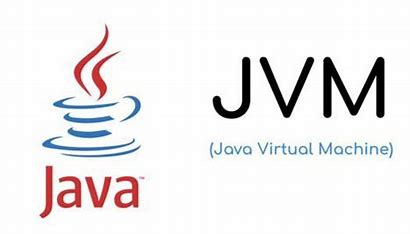Spring MVC
参考视频:B站狂神
1、回顾MVC架构
1.1 什么是MVC
- MVC 设计不仅限于 Java Web 应用,还包括许多应用,比如前端、PHP、.NET 等语言。之所以那么做的根本原因在于解耦各个模块。
MVC 是 Model、View 和 Controller 的缩写,分别代表 Web 应用程序中的 3 种职责。
- ==(Model)模型==:用于存储数据以及处理用户请求的业务逻辑。
- ==(View)视图==:向控制器提交数据,显示模型中的数据。
- ==(Controller)控制器==:根据视图提出的请求判断将请求和数据交给哪个模型处理,将处理后的有关结果交给哪个视图更新显示。
- MVC是一种软件设计规范。
- 是将业务逻辑、数据、显示分离的方法来组织代码。
- MVC主要作用是降低了视图与业务逻辑间的双向偶合。
- MVC不是一种设计模式,MVC是一种架构模式。当然不同的MVC存在差异。
基于 Servlet 的 MVC 模式的具体实现如下。
- 模型:一个或多个 JavaBean 对象,用于存储数据(实体模型,由 JavaBean 类创建)和处理业务逻辑(业务模型,由一般的 Java 类创建)。
- 视图:一个或多个 JSP 页面,向控制器提交数据和为模型提供数据显示,JSP 页面主要使用 HTML 标记和 JavaBean 标记来显示数据。
- 控制器:一个或多个 Servlet 对象,根据视图提交的请求进行控制,即将请求转发给处理业务逻辑的 JavaBean,并将处理结果存放到实体模型 JavaBean 中,输出给视图显示。
基于 Servlet 的 MVC 模式的流程如图所示。
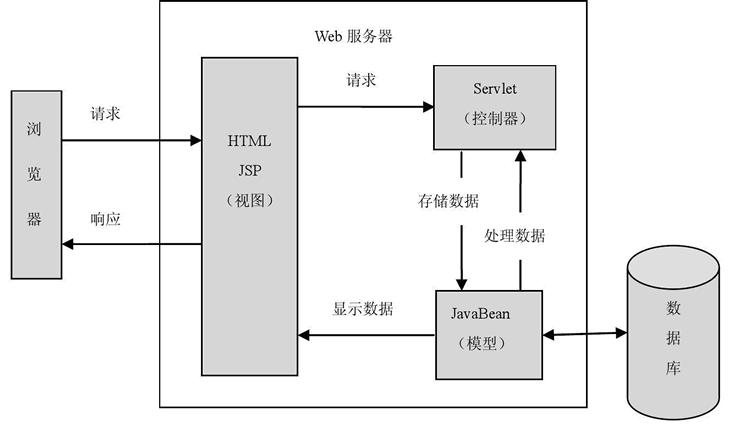
最典型的MVC就是JSP + servlet + javabean的模式。

1.2 Model1时代
- 在web早期的开发中,通常采用的都是Model1。
- Model1中,主要分为两层,视图层和模型层。

1.3 Model2时代
- Model2把一个项目分成三部分,包括视图、控制、模型。

职责分析:
Controller:控制器
Model:模型
View:视图
Model2这样不仅提高的代码的复用率与项目的扩展性,且大大降低了项目的维护成本。Model 1模式的实现比较简单,适用于快速开发小规模项目,Model1中JSP页面身兼View和Controller两种角色,将控制逻辑和表现逻辑混杂在一起,从而导致代码的重用性非常低,增加了应用的扩展性和维护的难度。Model2消除了Model1的缺点。
1.4 回顾Servlet
- 新建一个Maven工程当做父工程!pom依赖!

1
2
3
4
5
6
7
8
9
10
11
12
13
14
15
16
17
18
19
20
21
22
23
24
25
26
27
28
|
<dependencies>
<dependency>
<groupId>junit</groupId>
<artifactId>junit</artifactId>
<version>4.12</version>
</dependency>
<dependency>
<groupId>org.springframework</groupId>
<artifactId>spring-webmvc</artifactId>
<version>5.1.9.RELEASE</version>
</dependency>
<dependency>
<groupId>javax.servlet</groupId>
<artifactId>servlet-api</artifactId>
<version>2.5</version>
</dependency>
<dependency>
<groupId>javax.servlet.jsp</groupId>
<artifactId>jsp-api</artifactId>
<version>2.2</version>
</dependency>
<dependency>
<groupId>javax.servlet</groupId>
<artifactId>jstl</artifactId>
<version>1.2</version>
</dependency>
</dependencies>
|
- 建立一个Moudle:springmvc-01-servlet , 添加Web app的支持!




- 导入servlet 和 jsp 的 jar 依赖
1
2
3
4
5
6
7
8
9
10
11
12
13
|
<dependencies>
<dependency>
<groupId>javax.servlet</groupId>
<artifactId>servlet-api</artifactId>
<version>2.5</version>
</dependency>
<dependency>
<groupId>javax.servlet.jsp</groupId>
<artifactId>jsp-api</artifactId>
<version>2.2</version>
</dependency>
</dependencies>
|
- 编写一个Servlet类,用来处理用户的请求

1
2
3
4
5
6
7
8
9
10
11
12
13
14
15
16
17
18
19
20
21
22
23
24
25
26
27
28
29
30
31
32
| package com.github.test.servlet;
import javax.servlet.ServletException;
import javax.servlet.http.HttpServlet;
import javax.servlet.http.HttpServletRequest;
import javax.servlet.http.HttpServletResponse;
import java.io.IOException;
public class HelloServlet extends HttpServlet {
@Override
protected void doGet(HttpServletRequest req, HttpServletResponse resp) throws ServletException, IOException {
String method = req.getParameter("method");
if (method.equals("add")){
req.getSession().setAttribute("msg","执行add方法");
}
if (method.equals("delete")){
req.getSession().setAttribute("msg","执行delete方法");
}
req.getRequestDispatcher("/WEB-INF/jsp/Hello.jsp").forward(req,resp);
}
@Override
protected void doPost(HttpServletRequest req, HttpServletResponse resp) throws ServletException, IOException {
doGet(req,resp);
}
}
|
- 编写Hello.jsp,在WEB-INF目录下新建一个jsp的文件夹,新建Hello.jsp、Form.jsp

1
2
3
4
5
6
7
8
9
| <%@ page contentType="text/html;charset=UTF-8" language="java" %>
<html>
<head>
<title>testLY</title>
</head>
<body>
${msg}
</body>
</html>
|
1
2
3
4
5
6
7
8
9
10
11
12
13
14
| <%@ page contentType="text/html;charset=UTF-8" language="java" %>
<html>
<head>
<title>Title</title>
</head>
<body>
<form action="/hello" method="post">
<input type="text" name="method">
<input type="submit">
</form>
</body>
</html>
|
- 在web.xml中注册Servlet
1
2
3
4
5
6
7
8
9
10
11
12
13
14
15
16
| <?xml version="1.0" encoding="UTF-8"?>
<web-app xmlns="http://xmlns.jcp.org/xml/ns/javaee"
xmlns:xsi="http://www.w3.org/2001/XMLSchema-instance"
xsi:schemaLocation="http://xmlns.jcp.org/xml/ns/javaee http://xmlns.jcp.org/xml/ns/javaee/web-app_4_0.xsd"
version="4.0">
<servlet>
<servlet-name>HelloServlet</servlet-name>
<servlet-class>com.github.test.servlet.HelloServlet</servlet-class>
</servlet>
<servlet-mapping>
<servlet-name>HelloServlet</servlet-name>
<url-pattern>/hello</url-pattern>
</servlet-mapping>
</web-app>
|
- 配置Tomcat,并启动测试




MVC框架要做哪些事情
- 将url映射到java类或java类的方法。
- 封装用户提交的数据。
- 处理请求–调用相关的业务处理–封装响应数据。
- 将响应的数据进行渲染 . jsp / html 等表示层数据。
常见的服务器端MVC框架有:Struts、Spring MVC、ASP.NET MVC、Zend Framework、JSF;常见前端MVC框架:vue、angularjs、react、backbone;由MVC演化出了另外一些模式如:MVP、MVVM 等等….
MVVM扫盲
参考于:https://www.jianshu.com/p/0ae3c0d830e5
- MVVM是Model-View-ViewModel的简写。它==本质上就是MVC 的改进版==。
- MVVM(Model–View–Viewmodel)是一种软件架构模式。
MVC中的M就是单纯的从网络获取回来的数据模型,V指的我们的视图界面,而C就是我们的ViewController。
在其中,ViewController负责View和Model之间调度,View发生交互事件会通过target-action或者delegate方式回调给ViewController,与此同时ViewController还要承担把Model通过KVO、Notification方式传来的数据传输给View用于展示的责任。
随着业务越来越复杂,视图交互越复杂,导致Controller越来越臃肿,负重前行。脏活累活都它干了,到头来还一点不讨好。福报修多了的结果就是,不行了就重构你,重构不了就换掉你。

所以,为了解决这个问题,MVVM就闪亮登场了。他把View和Contrller都放在了View层(相当于把Controller一部分逻辑抽离了出来),Model层依然是服务端返回的数据模型。
而ViewModel充当了一个UI适配器的角色,也就是说View中每个UI元素都应该在ViewModel找到与之对应的属性。除此之外,从Controller抽离出来的与UI有关的逻辑都放在了ViewModel中,这样就减轻了Controller的负担。

从以上的架构图中,我们可以很清晰的梳理出各自的分工。
- View层:视图展示。包含UIView以及UIViewController,View层是可以持有ViewModel的。
- ViewModel层:视图适配器。暴露属性与View元素显示内容或者元素状态一一对应。一般情况下ViewModel暴露的属性建议是readOnly的,至于为什么,我们在实战中会去解释。还有一点,ViewModel层是可以持有Model的。
- Model层:数据模型与持久化抽象模型。数据模型很好理解,就是从服务器拉回来的JSON数据。而持久化抽象模型暂时放在Model层,是因为MVVM诞生之初就没有对这块进行很细致的描述。按照经验,我们通常把数据库、文件操作封装成Model,并对外提供操作接口。(有些公司把数据存取操作单拎出来一层,称之为DataAdapter层,所以在业内会有很多MVVM的变种,但其本质上都是MVVM)。
- Binder:MVVM的灵魂。可惜在MVVM这几个英文单词中并没有它的一席之地,它的最主要作用是在View和ViewModel之间做了双向数据绑定。如果MVVM没有Binder,那么它与MVC的差异不是很大。
我们发现,正是因为View、ViewModel以及Model间的清晰的持有关系,所以在三个模块间的数据流转有了很好的控制。
2、什么是SpringMVC
2.1 概述

Spring MVC是Spring Framework的一部分,是基于Java实现MVC的轻量级Web框架。
为什么要学习SpringMVC呢?
Spring MVC的特点:
- 轻量级,简单易学
- 高效 , 基于请求响应的MVC框架
- 与Spring兼容性好,无缝结合
- 约定优于配置
- 功能强大:RESTful、数据验证、格式化、本地化、主题等
- 简洁灵活
Spring的web框架围绕DispatcherServlet [ 调度Servlet ] 设计。
DispatcherServlet的作用是将请求分发到不同的处理器。从Spring 2.5开始,使用Java 5或者以上版本的用户可以采用基于注解形式进行开发,十分简洁;
正因为SpringMVC好 , 简单 , 便捷 , 易学 , 天生和Spring无缝集成(使用SpringIoC和Aop) , 使用约定优于配置 . 能够进行简单的junit测试 . 支持Restful风格 .异常处理 , 本地化 , 国际化 , 数据验证 , 类型转换 , 拦截器 等等……所以要学习。
最重要的一点还是用的人多 , 使用的公司多 .
2.2 中心控制器
Spring的web框架围绕DispatcherServlet设计。DispatcherServlet的作用是将请求分发到不同的处理器。从Spring 2.5开始,使用Java 5或者以上版本的用户可以采用基于注解的controller声明方式。
Spring MVC框架像许多其他MVC框架一样, 以请求为驱动 , 围绕一个中心Servlet分派请求及提供其他功能,**DispatcherServlet是一个实际的Servlet (它继承自HttpServlet 基类)**。

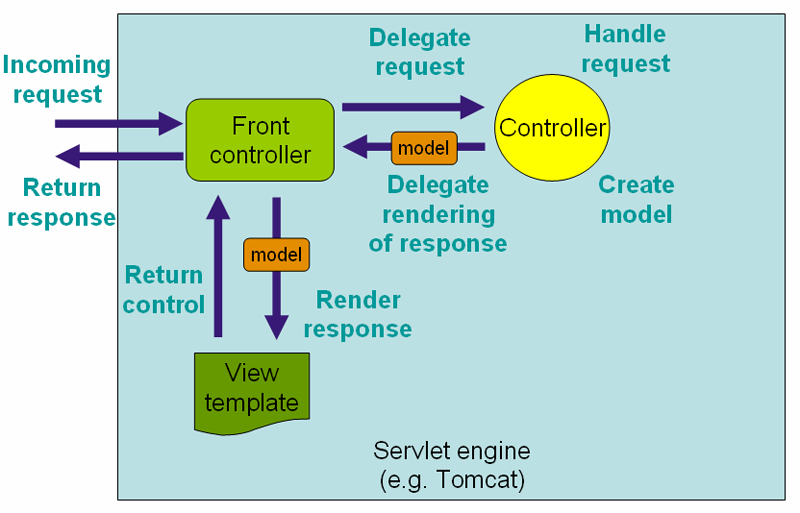
当发起请求时被前置的控制器拦截到请求,根据请求参数生成代理请求,找到请求对应的实际控制器,控制器处理请求,创建数据模型,访问数据库,将模型响应给中心控制器,控制器使用模型与视图渲染视图结果,将结果返回给中心控制器,再将结果返回给请求者。

2.3 SpringMVC执行原理

图为SpringMVC的一个较完整的流程图,实线表示SpringMVC框架提供的技术,不需要开发者实现,虚线表示需要开发者实现。
简要分析执行流程
DispatcherServlet表示前置控制器,是整个SpringMVC的控制中心。用户发出请求,DispatcherServlet接收请求并拦截请求。
假设请求的url为 : http://localhost:8080/SpringMVC/hello
如上url拆分成三部分:
http://localhost:8080:服务器域名
SpringMVC:部署在服务器上的web站点
hello:控制器
通过分析,如上url表示为:请求位于服务器localhost:8080上的SpringMVC站点的hello控制器。
HandlerMapping为处理器映射。DispatcherServlet调用HandlerMapping,HandlerMapping根据请求url查找Handler。
HandlerExecution表示具体的Handler,其主要作用是根据url查找控制器,如上url被查找控制器为:hello。
HandlerExecution将解析后的信息传递给DispatcherServlet,如解析控制器映射等。
HandlerAdapter表示处理器适配器,其按照特定的规则去执行Handler。
Handler让具体的Controller执行。
Controller将具体的执行信息返回给HandlerAdapter,如ModelAndView。
HandlerAdapter将视图逻辑名或模型传递给DispatcherServlet。
DispatcherServlet调用视图解析器(ViewResolver)来解析HandlerAdapter传递的逻辑视图名。
视图解析器将解析的逻辑视图名传给DispatcherServlet。
DispatcherServlet根据视图解析器解析的视图结果,调用具体的视图。
最终视图呈现给用户。
3、HelloSpring
提一句:==IDEA版本不建议使用2020.1,版本不稳定会经常报错==。本节因为报错排错半个月!!!
3.1 配置版
- 新建一个Moudle , springmvc-02-hellomvc , 添加web的支持!

确定导入了SpringMVC 的依赖!
配置web.xml , 注册DispatcherServlet
1
2
3
4
5
6
7
8
9
10
11
12
13
14
15
16
17
18
19
20
21
22
23
24
25
26
27
| <?xml version="1.0" encoding="UTF-8"?>
<web-app xmlns="http://xmlns.jcp.org/xml/ns/javaee"
xmlns:xsi="http://www.w3.org/2001/XMLSchema-instance"
xsi:schemaLocation="http://xmlns.jcp.org/xml/ns/javaee http://xmlns.jcp.org/xml/ns/javaee/web-app_4_0.xsd"
version="4.0">
<servlet>
<servlet-name>springmvc</servlet-name>
<servlet-class>org.springframework.web.servlet.DispatcherServlet</servlet-class>
<init-param>
<param-name>contextConfigLocation</param-name>
<param-value>classpath:springmvc-servlet.xml</param-value>
</init-param>
<load-on-startup>1</load-on-startup>
</servlet>
<servlet-mapping>
<servlet-name>springmvc</servlet-name>
<url-pattern>/</url-pattern>
</servlet-mapping>
</web-app>
|
- 编写SpringMVC 的 配置文件!名称:springmvc-servlet.xml : [servletname]-servlet.xml

1
2
3
4
5
6
7
| <?xml version="1.0" encoding="UTF-8"?>
<beans xmlns="http://www.springframework.org/schema/beans"
xmlns:xsi="http://www.w3.org/2001/XMLSchema-instance"
xsi:schemaLocation="http://www.springframework.org/schema/beans
http://www.springframework.org/schema/beans/spring-beans.xsd">
</beans>
|
- 添加处理映射器、 处理器适配器、 视图解析器
1
2
3
4
5
6
7
8
9
10
11
12
13
14
15
16
17
18
19
20
21
| <?xml version="1.0" encoding="UTF-8"?>
<beans xmlns="http://www.springframework.org/schema/beans"
xmlns:xsi="http://www.w3.org/2001/XMLSchema-instance"
xsi:schemaLocation="http://www.springframework.org/schema/beans
http://www.springframework.org/schema/beans/spring-beans.xsd">
<bean class="org.springframework.web.servlet.handler.BeanNameUrlHandlerMapping"/>
<bean class="org.springframework.web.servlet.mvc.SimpleControllerHandlerAdapter"/>
<bean class="org.springframework.web.servlet.view.InternalResourceViewResolver" id="InternalResourceViewResolver">
<property name="prefix" value="/WEB-INF/jsp/"/>
<property name="suffix" value=".jsp"/>
</bean>
</beans>
|
- 编写要操作业务Controller ,要么实现Controller接口,要么增加注解;需要返回一个ModelAndView,装数据,封视图;

1
2
3
4
5
6
7
8
9
10
11
12
13
14
15
16
17
18
19
20
21
22
23
| package com.github.test.controller;
import org.springframework.web.servlet.ModelAndView;
import org.springframework.web.servlet.mvc.Controller;
import javax.servlet.http.HttpServletRequest;
import javax.servlet.http.HttpServletResponse;
public class HelloController implements Controller {
public ModelAndView handleRequest(HttpServletRequest request, HttpServletResponse response) throws Exception {
ModelAndView mv = new ModelAndView();
mv.addObject("msg","HelloSpringMVC!");
mv.setViewName("hello");
return mv;
}
}
|
- 将自己的类交给SpringIOC容器,注册bean,添加到springmvc-servlet.xml中。
1
2
|
<bean id="/hello" class="com.github.test.controller.HelloController"/>
|
- 写要跳转的jsp页面,显示ModelandView存放的数据,以及正常页面;
1
2
3
4
5
6
7
8
9
| <%@ page contentType="text/html;charset=UTF-8" language="java" %>
<html>
<head>
<title>HelloSpringMVC</title>
</head>
<body>
${msg}
</body>
</html>
|
- 配置Tomcat,启动测试!


报错:Error:(3, 39) java: 程序包org.springframework.web.servlet不存在

- 解决方法:在WEB-INF中添加lib文件夹,手动加入spring-web-5.1.9.RELEASE.jar、spring-webmvc-5.1.9.RELEASE.jar的jar包。

报错:404,如下图:




3.2 注解版
- 新建一个Moudle,springmvc-03-hello-annotation ,添加web支持!

- 由于Maven可能存在资源过滤的问题,将配置完善,在pom.xml中添加如下:
1
2
3
4
5
6
7
8
9
10
11
12
13
14
15
16
17
18
19
20
| <build>
<resources>
<resource>
<directory>src/main/java</directory>
<includes>
<include>**/*.properties</include>
<include>**/*.xml</include>
</includes>
<filtering>false</filtering>
</resource>
<resource>
<directory>src/main/resources</directory>
<includes>
<include>**/*.properties</include>
<include>**/*.xml</include>
</includes>
<filtering>false</filtering>
</resource>
</resources>
</build>
|
在pom.xml文件引入相关的依赖:主要有Spring框架核心库、Spring MVC、servlet , JSTL等。==在父依赖中已经引入了==!
配置web.xml

1
2
3
4
5
6
7
8
9
10
11
12
13
14
15
16
17
18
19
20
21
22
23
24
25
26
| <?xml version="1.0" encoding="UTF-8"?>
<web-app xmlns="http://xmlns.jcp.org/xml/ns/javaee"
xmlns:xsi="http://www.w3.org/2001/XMLSchema-instance"
xsi:schemaLocation="http://xmlns.jcp.org/xml/ns/javaee http://xmlns.jcp.org/xml/ns/javaee/web-app_4_0.xsd"
version="4.0">
<servlet>
<servlet-name>SpringMVC</servlet-name>
<servlet-class>org.springframework.web.servlet.DispatcherServlet</servlet-class>
<init-param>
<param-name>contextConfigLocation</param-name>
<param-value>classpath:springmvc-servlet.xml</param-value>
</init-param>
<load-on-startup>1</load-on-startup>
</servlet>
<servlet-mapping>
<servlet-name>SpringMVC</servlet-name>
<url-pattern>/</url-pattern>
</servlet-mapping>
</web-app>
|
添加Spring MVC配置文件
在resource目录下添加springmvc-servlet.xml配置文件,配置的形式与Spring容器配置基本类似,为了支持基于注解的IOC,设置了自动扫描包的功能,具体配置信息如下:
1
2
3
4
5
6
7
8
9
10
11
12
13
14
15
16
17
18
19
20
21
22
23
24
25
26
27
28
29
30
31
32
33
34
35
36
37
| <?xml version="1.0" encoding="UTF-8"?>
<beans xmlns="http://www.springframework.org/schema/beans"
xmlns:xsi="http://www.w3.org/2001/XMLSchema-instance"
xmlns:context="http://www.springframework.org/schema/context"
xmlns:mvc="http://www.springframework.org/schema/mvc"
xsi:schemaLocation="http://www.springframework.org/schema/beans
http://www.springframework.org/schema/beans/spring-beans.xsd
http://www.springframework.org/schema/context
https://www.springframework.org/schema/context/spring-context.xsd
http://www.springframework.org/schema/mvc
https://www.springframework.org/schema/mvc/spring-mvc.xsd">
<context:component-scan base-package="com.github.test.controller"/>
<mvc:default-servlet-handler />
<mvc:annotation-driven />
<bean class="org.springframework.web.servlet.view.InternalResourceViewResolver"
id="internalResourceViewResolver">
<property name="prefix" value="/WEB-INF/jsp/" />
<property name="suffix" value=".jsp" />
</bean>
</beans>
|
- 创建Controller,编写一个Java控制类:com.github.test.controller.HelloController , 注意编码规范
1
2
3
4
5
6
7
8
9
10
11
12
13
14
15
16
17
18
19
| package com.github.test.controller;
import org.springframework.stereotype.Controller;
import org.springframework.ui.Model;
import org.springframework.web.bind.annotation.RequestMapping;
@Controller
@RequestMapping("/HelloController")
public class HelloController {
@RequestMapping("/hello")
public String sayHello(Model model){
model.addAttribute("msg","hello,SpringMVC");
return "hello";
}
}
|
- @Controller是为了让Spring IOC容器初始化时自动扫描到;
- @RequestMapping是为了映射请求路径,这里因为类与方法上都有映射所以访问时应该是/HelloController/hello;
- 方法中声明Model类型的参数是为了把Action中的数据带到视图中;
- 方法返回的结果是视图的名称hello,加上配置文件中的前后缀变成WEB-INF/jsp/hello.jsp。
- 创建视图层
- 在WEB-INF/ jsp目录中创建hello.jsp , 视图可以直接取出并展示从Controller带回的信息;

- 可以通过EL表示取出Model中存放的值,或者对象;
1
2
3
4
5
6
7
8
9
| <%@ page contentType="text/html;charset=UTF-8" language="java" %>
<html>
<head>
<title>SpringMVC</title>
</head>
<body>
${msg}
</body>
</html>
|
- 还要手动配置lib包。

- 配置Tomcat运行,开启服务器,访问对应的请求路径!


3.3 小结
实现步骤:
- 新建一个web项目
- 导入相关jar包
- 编写web.xml , 注册DispatcherServlet
- 编写springmvc配置文件
- 接下来就是去创建对应的控制类 , controller
- 最后完善前端视图和controller之间的对应
- 测试运行调试.
使用springMVC必须配置的三大件:
通常,我们只需要手动配置视图解析器,而处理器映射器和处理器适配器只需要开启注解驱动即可,而省去了大段的xml配置。

4、RestFul和Controller
1.控制器Controller
- 控制器复杂提供访问应用程序的行为,通常可以通过接口定义或注解定义两种方法实现。
- 控制器负责解析用户的请求并将其转换为一个模型。
- 在Spring MVC中一个控制器类可以包含多个方法
- 在Spring MVC中,对于Controller的配置方式有很多种
2.实现Controller接口
Controller是一个接口,在org.springframework.web.servlet.mvc包下,接口中只有一个方法;
1
2
3
4
5
|
public interface Controller {
ModelAndView handleRequest(HttpServletRequest var1, HttpServletResponse var2) throws Exception;
}
|
新建一个Moudle,springmvc-04-controller 。将刚才的03拷贝一份, 进行操作!




1
2
3
4
5
6
7
8
9
10
11
12
13
14
15
16
17
18
19
20
21
22
23
24
25
26
| <?xml version="1.0" encoding="UTF-8"?>
<web-app xmlns="http://xmlns.jcp.org/xml/ns/javaee"
xmlns:xsi="http://www.w3.org/2001/XMLSchema-instance"
xsi:schemaLocation="http://xmlns.jcp.org/xml/ns/javaee http://xmlns.jcp.org/xml/ns/javaee/web-app_4_0.xsd"
version="4.0">
<servlet>
<servlet-name>SpringMVC</servlet-name>
<servlet-class>org.springframework.web.servlet.DispatcherServlet</servlet-class>
<init-param>
<param-name>contextConfigLocation</param-name>
<param-value>classpath:springmvc-servlet.xml</param-value>
</init-param>
<load-on-startup>1</load-on-startup>
</servlet>
<servlet-mapping>
<servlet-name>SpringMVC</servlet-name>
<url-pattern>/</url-pattern>
</servlet-mapping>
</web-app>
|
- springmvc-servlet.xml,mvc的配置文件只留下视图解析器!
1
2
3
4
5
6
7
8
9
10
11
12
13
14
15
16
| <?xml version="1.0" encoding="UTF-8"?>
<beans xmlns="http://www.springframework.org/schema/beans"
xmlns:xsi="http://www.w3.org/2001/XMLSchema-instance"
xsi:schemaLocation="http://www.springframework.org/schema/beans
http://www.springframework.org/schema/beans/spring-beans.xsd">
<bean class="org.springframework.web.servlet.view.InternalResourceViewResolver"
id="internalResourceViewResolver">
<property name="prefix" value="/WEB-INF/jsp/" />
<property name="suffix" value=".jsp" />
</bean>
</beans>
|
- 编写一个Controller类,ControllerTest.java

1
2
3
4
5
6
7
8
9
10
11
12
13
14
15
16
17
18
19
| package com.github.test.controller;
import org.springframework.web.servlet.ModelAndView;
import org.springframework.web.servlet.mvc.Controller;
import javax.servlet.http.HttpServletRequest;
import javax.servlet.http.HttpServletResponse;
public class ControllerTest implements Controller {
public ModelAndView handleRequest(HttpServletRequest httpServletRequest, HttpServletResponse httpServletResponse) throws Exception {
ModelAndView mv = new ModelAndView();
mv.addObject("msg","ControllerTest");
mv.setViewName("test");
return mv;
}
}
|
编写完毕后,去Spring配置文件中注册请求的bean;name对应请求路径,class对应处理请求的类。

1
| <bean name="/t1" class="com.github.test.controller.ControllerTest"/>
|
编写前端test.jsp,注意在WEB-INF/jsp目录下编写,方便对应视图解析器。

1
2
3
4
5
6
7
8
9
| <%@ page contentType="text/html;charset=UTF-8" language="java" %>
<html>
<head>
<title>Title</title>
</head>
<body>
${msg}
</body>
</html>
|
- 配置Tomcat运行测试,我这里项目发布名配置是/springmvc_04,如果没写,只是一个 / ,则请求不用加项目名,直接运行即可。不影响!


- ==注==
- 实现接口Controller定义控制器是较老的办法;
- 缺点是:一个控制器中只有一个方法,如果要多个方法则需要定义多个Controller;定义的方式比较麻烦。
3.使用注解@Controller
- @Controller注解类型用于声明Spring类的实例是一个控制器;
- Spring可以使用扫描机制来找到应用程序中所有基于注解的控制器类,为了保证Spring能找到你的控制器,需要在配置文件中声明组件扫描。

1
2
|
<context:component-scan base-package="com.github.test.controller"/>
|
- 增加一个ControllerTest2类,使用注解实现;

1
2
3
4
5
6
7
8
9
10
11
12
13
14
15
16
17
18
| package com.github.test.controller;
import org.springframework.stereotype.Controller;
import org.springframework.ui.Model;
import org.springframework.web.bind.annotation.RequestMapping;
@Controller
public class ControllerTest2 {
@RequestMapping("/t2")
public String index(Model model){
model.addAttribute("msg", "ControllerTest2");
return "test";
}
}
|
- 运行tomcat测试。测试路径:http://localhost:8080/springmvc_04/t2

可以发现:两个请求都可以指向一个视图,但是页面结果的结果是不一样的,从这里可以看出视图是被复用的,而控制器与视图之间是弱偶合关系。
注解方式是平时使用的最多的方式!
4.RequestMapping
@RequestMapping
- @RequestMapping注解用于映射url到控制器类或一个特定的处理程序方法。可用于类或方法上。用于类上,表示类中的所有响应请求的方法都是以该地址作为父路径。
- 只注解在方法上面。

1
2
3
4
5
6
7
8
9
10
11
12
13
14
| package com.github.test.controller;
import org.springframework.stereotype.Controller;
import org.springframework.web.bind.annotation.RequestMapping;
@Controller
public class ControllerTest3 {
@RequestMapping("/h1")
public String test(){
return "test";
}
}
|


1
2
3
4
5
6
7
8
9
10
11
12
13
14
15
| package com.github.test.controller;
import org.springframework.stereotype.Controller;
import org.springframework.ui.Model;
import org.springframework.web.bind.annotation.RequestMapping;
@Controller
@RequestMapping("/s1")
public class ControllerTest3 {
@RequestMapping("/y1")
public String test(Model model){
model.addAttribute("msg","s1/y1");
return "test";
}
}
|

5.RestFul
Restful就是一个资源定位及资源操作的风格。不是标准也不是协议,只是一种风格。基于这个风格设计的软件可以更简洁,更有层次,更易于实现缓存等机制。
功能
- 资源:互联网所有的事物都可以被抽象为资源;
- 资源操作:使用POST、DELETE、PUT、GET,使用不同方法对资源进行操作。分别对应 添加、 删除、修改、查询。
传统方式操作资源 :通过不同的参数来实现不同的效果!方法单一,post 和 get
使用RESTful操作资源 :可以通过不同的请求方式来实现不同的效果!如下:请求地址一样,但是功能可以不同!
案例测试
- 再新建一个类 RestFulController。

1
2
3
4
5
6
7
8
| package com.github.test.controller;
import org.springframework.stereotype.Controller;
@Controller
public class RestFulController {
}
|
1
2
3
4
5
6
7
8
9
10
11
12
13
14
15
16
17
18
19
20
21
22
23
| package com.github.test.controller;
import org.springframework.stereotype.Controller;
import org.springframework.ui.Model;
import org.springframework.web.bind.annotation.RequestMapping;
@Controller
public class RestFulController {
@RequestMapping("/add")
public String index( int p1, int p2, Model model){
int result = p1+p2;
model.addAttribute("msg", "加法结果:"+result);
return "test";
}
}
|

- 在Spring MVC中可以使用 @PathVariable 注解,让方法参数的值对应绑定到一个URI模板变量上。

1
2
3
4
5
6
7
8
9
10
11
12
13
14
15
16
17
18
19
20
21
22
23
24
| package com.github.test.controller;
import org.springframework.stereotype.Controller;
import org.springframework.ui.Model;
import org.springframework.web.bind.annotation.PathVariable;
import org.springframework.web.bind.annotation.RequestMapping;
@Controller
public class RestFulController {
@RequestMapping("/add/{p1}/{p2}")
public String index(@PathVariable int p1, @PathVariable int p2, Model model){
int result = p1+p2;
model.addAttribute("msg", "加法结果:"+result);
return "test";
}
}
|
- 测试请求并查看。

思考:使用路径变量的好处?
- 使路径变得更加简洁;
- 获得参数更加方便,框架会自动进行类型转换。
- 通过路径变量的类型可以约束访问参数,如果类型不一样,则访问不到对应的请求方法,如这里访问是的路径是/add/9/k,则路径与方法不匹配,而不会是参数转换失败。

- 修改下对应的参数类型,再次测试
1
2
3
4
5
6
7
8
9
10
11
12
13
14
15
16
17
18
19
20
21
22
23
24
| package com.github.test.controller;
import org.springframework.stereotype.Controller;
import org.springframework.ui.Model;
import org.springframework.web.bind.annotation.PathVariable;
import org.springframework.web.bind.annotation.RequestMapping;
@Controller
public class RestFulController {
@RequestMapping("/add/{p1}/{p2}")
public String index(@PathVariable int p1, @PathVariable String p2, Model model){
String result = p1+p2;
model.addAttribute("msg", "字符结果:"+result);
return "test";
}
}
|

使用method属性指定请求类型
- 用于约束请求的类型,可以收窄请求范围。指定请求谓词的类型如GET, POST, HEAD, OPTIONS, PUT, PATCH, DELETE, TRACE等。
案例测试:

1
2
3
4
5
6
|
@RequestMapping(value = "/home",method = {RequestMethod.POST})
public String index2(Model model){
model.addAttribute("msg", "My warm home!");
return "test";
}
|
- 使用浏览器地址栏进行访问默认是Get请求,会报错405:

1
2
3
4
5
6
|
@RequestMapping(value = "/home",method = {RequestMethod.GET})
public String index2(Model model){
model.addAttribute("msg", "My warm home!");
return "test";
}
|

Spring MVC 的 @RequestMapping 注解能够处理 HTTP 请求的方法, 比如 GET, PUT, POST, DELETE 以及 PATCH。
- 所有的地址栏请求默认都会是 HTTP GET 类型的。
- 方法级别的注解变体有如下几个:组合注解
1
2
3
4
5
| @GetMapping
@PostMapping
@PutMapping
@DeleteMapping
@PatchMapping
|
@GetMapping 是一个组合注解,平时使用的会比较多!它所扮演的是 @RequestMapping(method =RequestMethod.GET) 的一个快捷方式。
6.每个程序员都要知道的:小黄鸭调试法
转载自《程序员的那些事》
花了一下午(或一天)在试图解决某个 Bug,后来才知道解决方案很简单,当时就是没有想到。
有个同事正好路过,看到你愁眉苦脸的,问你“怎么了呀?”
“噢,是这样的。我遇到了一个问题,点击这个控件的时……” 当你正准备和同事详细解释的时候,突然灵光一现,你话都没说完,就中断了和同事的倾诉,继续干活了。
同事微微一笑,又走开了。他并没有怪你。
「程序员的那些事」主页君相信大家都有类似的经历。遇到 Bug/问题被卡住了,拉个人过来,和他 blablabla 讲了一通,很多时候中途你就找到了解决办法。
有时候,并不一定要和人倾诉,还可以像其他东西倾诉,强迫自己把遇到的问题,详细地解释出来(一定要说出来)。
其实呢。这种方法,有一个术语:小黄鸭调试法(Rubber Duck Debugging)。
维基百科有解释:小黄鸭调试法是软件工程中使用的调试代码方法之一。就是在程序的调试、纠错或测试过程中,耐心地向小黄鸭解释每一行程序的作用,以此来激发灵感。
名称由来
此概念是参照于一个故事。故事中程序大师随身携带一只小黄鸭,在调试代码的时候会在桌上放上这只小黄鸭,然后详细地向鸭子解释每行代码。

5、数据处理及跳转
1.ModelAndView
- 设置ModelAndView对象 , 根据view的名称 , 和视图解析器跳到指定的页面;
- 页面 : {视图解析器前缀} + viewName +{视图解析器后缀}
1
2
3
4
5
6
7
8
|
<bean class="org.springframework.web.servlet.view.InternalResourceViewResolver"
id="internalResourceViewResolver">
<property name="prefix" value="/WEB-INF/jsp/" />
<property name="suffix" value=".jsp" />
</bean>
|
1
2
3
4
5
6
7
8
9
10
| public class ControllerTest implements Controller {
public ModelAndView handleRequest(HttpServletRequest httpServletRequest, HttpServletResponse httpServletResponse) throws Exception {
ModelAndView mv = new ModelAndView();
mv.addObject("msg","ControllerTest1");
mv.setViewName("test");
return mv;
}
}
|
2.ServletAPI
通过设置ServletAPI , 不需要视图解析器。
- 通过HttpServletResponse进行输出;
- 通过HttpServletResponse实现重定向;
- 通过HttpServletResponse实现转发。
1
2
3
4
5
6
7
8
9
10
11
12
13
14
15
16
17
18
19
20
21
22
23
24
25
26
27
28
29
30
31
32
33
34
35
36
37
| package com.github.test.controller;
import org.springframework.stereotype.Controller;
import org.springframework.web.bind.annotation.RequestMapping;
import javax.servlet.http.HttpServletRequest;
import javax.servlet.http.HttpServletResponse;
import javax.servlet.http.HttpSession;
import java.io.IOException;
@Controller
public class ModelTest1 {
@RequestMapping("/m1/t1")
public String test(HttpServletRequest request, HttpServletResponse response){
HttpSession session = request.getSession();
System.out.println(session.getId());
return "test";
}
@RequestMapping("/m2/t1")
public void test1(HttpServletRequest req, HttpServletResponse rsp) throws IOException {
rsp.getWriter().println("Hello,Spring BY servlet API");
}
@RequestMapping("/m2/t2")
public void test2(HttpServletRequest req, HttpServletResponse rsp) throws IOException {
rsp.sendRedirect("/index.jsp");
}
@RequestMapping("/m2/t3")
public void test3(HttpServletRequest req, HttpServletResponse rsp) throws Exception {
req.setAttribute("msg","/result/t3");
req.getRequestDispatcher("/WEB-INF/jsp/test.jsp").forward(req,rsp);
}
}
|


3.SpringMVC
通过SpringMVC来实现转发和重定向 - 无需视图解析器;

1
2
3
4
5
6
7
8
9
10
11
12
13
14
15
16
17
18
19
20
21
22
23
24
25
26
27
28
29
| package com.github.test.controller;
import org.springframework.stereotype.Controller;
import org.springframework.ui.Model;
import org.springframework.web.bind.annotation.RequestMapping;
@Controller
public class ResultSpringMVC {
@RequestMapping("/k1/t1")
public String test(Model model){
model.addAttribute("msg","ResultSpringMVC1");
return "/WEB-INF/jsp/test.jsp";
}
@RequestMapping("/k1/t2")
public String test2(Model model){
model.addAttribute("msg","ResultSpringMVC2");
return "forward:/WEB-INF/jsp/test.jsp";
}
@RequestMapping("/k1/t3")
public String test3(Model model){
model.addAttribute("msg","ResultSpringMVC3");
return "redirect:/index.jsp";
}
}
|



通过SpringMVC来实现转发和重定向 - 有视图解析器;
- 重定向 , 不需要视图解析器 , 本质就是重新请求一个新地方嘛 , 所以注意路径问题。
- 可以重定向到另外一个请求实现。

1
2
3
4
5
6
7
8
9
10
11
12
13
14
15
16
17
18
19
20
21
22
23
24
| package com.github.test.controller;
import org.springframework.stereotype.Controller;
import org.springframework.ui.Model;
import org.springframework.web.bind.annotation.RequestMapping;
@Controller
public class ResultSpringMVC {
@RequestMapping("/p1/t1")
public String test4(Model model){
model.addAttribute("msg","ResultSpringMVC4");
return "test";
}
@RequestMapping("/p1/t2")
public String test5(Model model){
model.addAttribute("msg","ResultSpringMVC5");
return "redirect:/index.jsp";
}
}
|


4.处理提交数据
1、提交的域名称和处理方法的参数名一致
1
2
3
4
5
6
7
8
9
10
11
12
13
14
15
16
17
18
19
20
21
| package com.github.test.controller;
import org.springframework.stereotype.Controller;
import org.springframework.ui.Model;
import org.springframework.web.bind.annotation.GetMapping;
import org.springframework.web.bind.annotation.RequestMapping;
@Controller
@RequestMapping("user")
public class UserController {
@GetMapping("/t1")
public String test(String name, Model model){
System.out.println("接收到前端的参数为:" + name);
model.addAttribute("msg","name");
return "test";
}
}
|

2、提交的域名称和处理方法的参数名不一致
1
2
3
4
5
6
7
8
9
10
11
12
13
14
15
16
17
18
19
20
21
22
23
| package com.github.test.controller;
import org.springframework.stereotype.Controller;
import org.springframework.ui.Model;
import org.springframework.web.bind.annotation.GetMapping;
import org.springframework.web.bind.annotation.RequestMapping;
import org.springframework.web.bind.annotation.RequestParam;
@Controller
@RequestMapping("user")
public class UserController {
@GetMapping("/t2")
public String hello(@RequestParam("username") String name, Model model){
System.out.println("接收到前端的参数为:" + name);
model.addAttribute("msg","username");
return "test";
}
}
|

3、提交的是一个对象
- 要求提交的表单域和对象的属性名一致 , 参数使用对象即可
- 实体类
1
2
3
4
5
6
7
8
9
10
11
12
13
14
15
16
17
18
19
20
21
22
23
24
25
26
27
28
29
30
31
32
33
34
35
36
37
38
39
40
41
42
43
44
45
46
47
48
49
| package com.github.test.pojo;
public class User {
private int id;
private String name;
private int age;
public int getId() {
return id;
}
public void setId(int id) {
this.id = id;
}
public String getName() {
return name;
}
public void setName(String name) {
this.name = name;
}
public int getAge() {
return age;
}
public void setAge(int age) {
this.age = age;
}
public User() {
}
public User(int id, String name, int age) {
this.id = id;
this.name = name;
this.age = age;
}
@Override
public String toString() {
return "User{" +
"id=" + id +
", name='" + name + '\'' +
", age=" + age +
'}';
}
}
|
提交数据:http://localhost:8080/springmvc_04/user/t3?name=test&id=4&age=21
处理方法 :
1
2
3
4
5
6
7
8
9
10
11
12
13
14
15
16
17
18
19
20
21
22
23
| package com.github.test.controller;
import com.github.test.pojo.User;
import org.springframework.stereotype.Controller;
import org.springframework.ui.Model;
import org.springframework.web.bind.annotation.GetMapping;
import org.springframework.web.bind.annotation.RequestMapping;
import org.springframework.web.bind.annotation.RequestParam;
@Controller
@RequestMapping("user")
public class UserController {
@GetMapping("/t3")
public String user(User user, Model model){
System.out.println("接收到前端的参数为:" + user);
model.addAttribute("msg","user");
return "test";
}
}
|

说明:如果使用对象的话,前端传递的参数名和对象名必须一致,否则就是null。
5.数据显示到前端
第一种 : 通过ModelAndView,最普遍的一种。
1
2
3
4
5
6
7
8
9
| public class ControllerTest implements Controller {
public ModelAndView handleRequest(HttpServletRequest httpServletRequest, HttpServletResponse httpServletResponse) throws Exception {
ModelAndView mv = new ModelAndView();
mv.addObject("msg","ControllerTest");
mv.setViewName("test");
return mv;
}
}
|
第二种 : 通过Model
1
2
3
4
5
6
7
8
9
10
11
| @GetMapping("/t2")
public String hello(@RequestParam("username") String name, Model model){
System.out.println("接收到前端的参数为:" + name);
model.addAttribute("msg","username");
return "test";
}
|
第三种 : 通过ModelMap
1
2
3
4
5
6
7
8
9
10
11
12
13
14
15
16
17
18
19
20
21
22
23
24
25
26
27
| package com.github.test.controller;
import com.github.test.pojo.User;
import org.springframework.stereotype.Controller;
import org.springframework.ui.Model;
import org.springframework.ui.ModelMap;
import org.springframework.web.bind.annotation.GetMapping;
import org.springframework.web.bind.annotation.RequestMapping;
import org.springframework.web.bind.annotation.RequestParam;
@Controller
@RequestMapping("user")
public class UserController {
@GetMapping("/t4")
public String test2(@RequestParam("username") String name, ModelMap model){
System.out.println("接收到前端的参数为:" + name);
model.addAttribute("msg","username2");
return "test";
}
}
|

简单来说使用区别就是:
- Model 只有寥寥几个方法只适合用于储存数据,简化了新手对于Model对象的操作和理解;
- ==ModelMap 继承了 LinkedMap==,除了实现了自身的一些方法,同样的继承 LinkedMap 的方法和特性;
- ModelAndView 可以在储存数据的同时,可以进行设置返回的逻辑视图,进行控制展示层的跳转。
==请使用80%的时间打好扎实的基础,剩下18%的时间研究框架,2%的时间去学点英文,框架的官方文档永远是最好的教程。==
6.乱码问题
案例
- 在首页编写一个提交的表单。
1
2
3
4
5
6
7
8
9
10
11
12
| <%@ page contentType="text/html;charset=UTF-8" language="java" %>
<html>
<head>
<title>Title</title>
</head>
<body>
<form action="/springmvc_04/e/t1" method="post">
<input type="text" name="name">
<input type="submit">
</form>
</body>
</html>
|
- 在后台编写对应的处理类。
1
2
3
4
5
6
7
8
9
10
11
12
13
14
15
16
| package com.github.test.controller;
import org.springframework.stereotype.Controller;
import org.springframework.ui.Model;
import org.springframework.web.bind.annotation.PostMapping;
@Controller
public class EncodingController {
@PostMapping("/e/t1")
public String test(Model model, String name){
model.addAttribute("msg",name);
return "test";
}
}
|
- 输入中文测试,发现乱码。

以前乱码问题通过过滤器解决 , 而SpringMVC给我们提供了一个过滤器 , 可以在web.xml中配置。
1
2
3
4
5
6
7
8
9
10
11
12
| <filter>
<filter-name>encoding</filter-name>
<filter-class>org.springframework.web.filter.CharacterEncodingFilter</filter-class>
<init-param>
<param-name>encoding</param-name>
<param-value>utf-8</param-value>
</init-param>
</filter>
<filter-mapping>
<filter-name>encoding</filter-name>
<url-pattern>/*</url-pattern>
</filter-mapping>
|
- 但是会发现:有些极端情况下,这个过滤器对get的支持不好。
- 处理方法 :
- 修改tomcat配置文件,设置编码!

1
2
3
| <Connector URIEncoding="utf-8" port="8080" protocol="HTTP/1.1"
connectionTimeout="20000"
redirectPort="8443" />
|
- 自定义过滤器,修改web.xml文件

1
2
3
4
5
6
7
8
9
10
11
12
13
14
15
16
17
18
19
20
21
22
23
24
25
26
27
28
29
30
31
32
33
34
35
36
37
38
39
40
41
42
43
44
45
46
47
48
49
50
51
52
53
54
55
56
57
58
59
60
61
62
63
64
65
66
67
68
69
70
71
72
73
74
75
76
77
78
79
80
81
82
83
84
85
86
87
88
89
90
91
92
93
94
95
96
97
98
99
100
101
102
103
104
105
| package com.github.test.filter;
import javax.servlet.*;
import javax.servlet.http.HttpServletRequest;
import javax.servlet.http.HttpServletRequestWrapper;
import javax.servlet.http.HttpServletResponse;
import java.io.IOException;
import java.io.UnsupportedEncodingException;
import java.util.Map;
public class GenericEncodingFilter implements Filter {
public void destroy() {
}
public void doFilter(ServletRequest request, ServletResponse response, FilterChain chain) throws IOException, ServletException {
HttpServletResponse myResponse=(HttpServletResponse) response;
myResponse.setContentType("text/html;charset=UTF-8");
HttpServletRequest httpServletRequest = (HttpServletRequest) request;
HttpServletRequest myrequest = new MyRequest(httpServletRequest);
chain.doFilter(myrequest, response);
}
public void init(FilterConfig filterConfig) throws ServletException {
}
}
class MyRequest extends HttpServletRequestWrapper {
private HttpServletRequest request;
private boolean hasEncode;
public MyRequest(HttpServletRequest request) {
super(request);
this.request = request;
}
@Override
public Map getParameterMap() {
String method = request.getMethod();
if (method.equalsIgnoreCase("post")) {
try {
request.setCharacterEncoding("utf-8");
return request.getParameterMap();
} catch (UnsupportedEncodingException e) {
e.printStackTrace();
}
} else if (method.equalsIgnoreCase("get")) {
Map<String, String[]> parameterMap = request.getParameterMap();
if (!hasEncode) {
for (String parameterName : parameterMap.keySet()) {
String[] values = parameterMap.get(parameterName);
if (values != null) {
for (int i = 0; i < values.length; i++) {
try {
values[i] = new String(values[i]
.getBytes("ISO-8859-1"), "utf-8");
} catch (UnsupportedEncodingException e) {
e.printStackTrace();
}
}
}
}
hasEncode = true;
}
return parameterMap;
}
return super.getParameterMap();
}
@Override
public String getParameter(String name) {
Map<String, String[]> parameterMap = getParameterMap();
String[] values = parameterMap.get(name);
if (values == null) {
return null;
}
return values[0];
}
@Override
public String[] getParameterValues(String name) {
Map<String, String[]> parameterMap = getParameterMap();
String[] values = parameterMap.get(name);
return values;
}
}
|

- 一般情况下,SpringMVC默认的乱码处理就已经能够很好的解决了
- 然后在web.xml中配置这个过滤器即可!
- 乱码问题,需要平时多注意,在尽可能能设置编码的地方,都设置为统一编码 UTF-8!
6、Json交互处理
1.Json
什么是JSON?
- JSON(JavaScript Object Notation, JS 对象标记) 是一种轻量级的数据交换格式,目前使用特别广泛。
- 采用完全独立于编程语言的文本格式来存储和表示数据。
- 简洁和清晰的层次结构使得 JSON 成为理想的数据交换语言。
- 易于人阅读和编写,同时也易于机器解析和生成,并有效地提升网络传输效率。
在 JavaScript 语言中,一切都是对象。因此,任何JavaScript 支持的类型都可以通过 JSON 来表示,例如字符串、数字、对象、数组等。看看他的要求和语法格式:
- 对象表示为键值对,数据由逗号分隔
- 花括号保存对象
- 方括号保存数组
JSON 键值对是用来保存 JavaScript 对象的一种方式,和 JavaScript 对象的写法也大同小异,键/值对组合中的键名写在前面并用双引号 “” 包裹,使用冒号 : 分隔,然后紧接着值:
1
2
3
| {"name": "test"}
{"age": "4"}
{"sex": "man"}
|
JSON 和 JavaScript 对象的关系:
- JSON 是 JavaScript 对象的字符串表示法,它使用文本表示一个 JS 对象的信息,本质是一个字符串。
1
2
| var obj = {a: 'Hello', b: 'World'};
var json = '{"a": "Hello", "b": "World"}';
|
JSON 和 JavaScript 对象互转
- 要实现从JSON字符串转换为JavaScript 对象,使用 JSON.parse() 方法:
1
2
| var obj = JSON.parse('{"a": "Hello", "b": "World"}');
|
- 要实现从JavaScript 对象转换为JSON字符串,使用 JSON.stringify() 方法:
1
2
| var json = JSON.stringify({a: 'Hello', b: 'World'});
|
2.JSON案例
- 新建一个module,springmvc-05-json , 添加web的支持

- 在web目录下新建一个 jsontest.html , 编写测试内容:
1
2
3
4
5
6
7
8
9
10
11
12
13
14
15
16
17
18
19
20
| <!DOCTYPE html>
<html lang="en">
<head>
<meta charset="UTF-8">
<title>JSON_苏北</title>
</head>
<body>
<script type="text/javascript">
var user = {
name:"test",
age:4,
sex:"man"
}
console.log(user);
</script>
</body>
</html>
|

1
2
3
4
5
6
7
8
9
10
11
12
13
14
15
16
17
18
19
20
21
22
23
24
| <!DOCTYPE html>
<html lang="en">
<head>
<meta charset="UTF-8">
<title>JSON_苏北</title>
</head>
<body>
<script type="text/javascript">
var user = {
name:"test",
age:4,
sex:"man"
}
var json = JSON.stringify(user);
console.log(json);
console.log(user);
</script>
</body>
</html>
|

1
2
3
4
5
6
7
8
9
10
11
12
13
14
15
16
17
18
19
20
21
22
23
24
25
26
27
28
29
30
31
| <!DOCTYPE html>
<html lang="en">
<head>
<meta charset="UTF-8">
<title>JSON_苏北</title>
</head>
<body>
<script type="text/javascript">
var user = {
name:"test",
age:4,
sex:"man"
}
console.log(user);
var json = JSON.stringify(user);
console.log(json);
console.log("------------------");
var obj = JSON.parse(json);
console.log(obj);
</script>
</body>
</html>
|
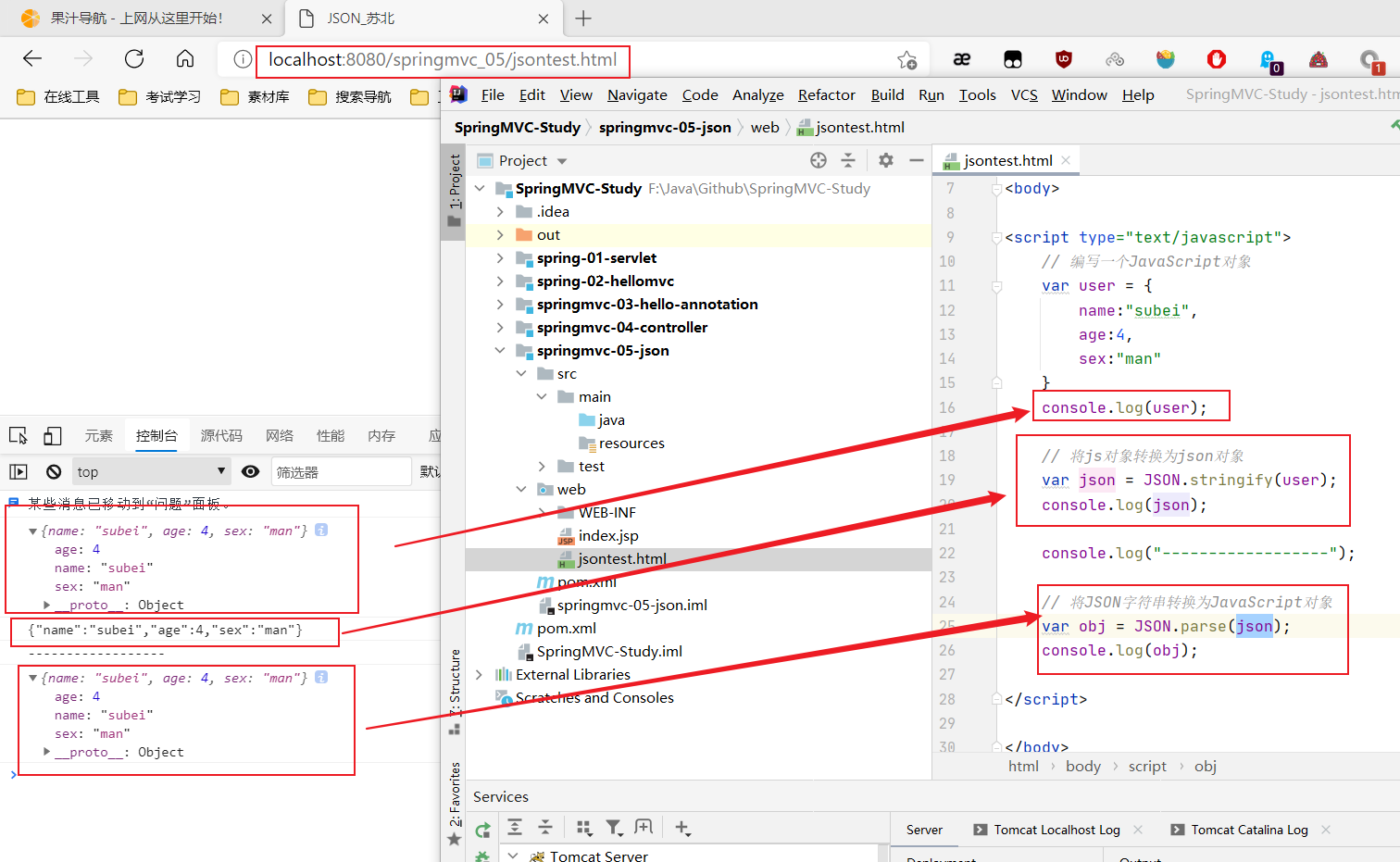
3.Jackson使用
Jackson应该是一种使用比较好的json解析工具。 类似工具很多,如阿里巴巴的 fastjson 等 ,不做过多赘述!
1.案例说明
- 导入它的jar包到pom.xml;


1
2
3
4
5
6
7
| <dependencies>
<dependency>
<groupId>com.fasterxml.jackson.core</groupId>
<artifactId>jackson-databind</artifactId>
<version>2.12.1</version>
</dependency>
</dependencies>
|
- 配置SpringMVC需要的配置:web.xml
1
2
3
4
5
6
7
8
9
10
11
12
13
14
15
16
17
18
19
20
21
22
23
24
25
26
27
28
29
30
31
32
33
34
35
36
37
38
39
| <?xml version="1.0" encoding="UTF-8"?>
<web-app xmlns="http://xmlns.jcp.org/xml/ns/javaee"
xmlns:xsi="http://www.w3.org/2001/XMLSchema-instance"
xsi:schemaLocation="http://xmlns.jcp.org/xml/ns/javaee http://xmlns.jcp.org/xml/ns/javaee/web-app_4_0.xsd"
version="4.0">
<servlet>
<servlet-name>SpringMVC</servlet-name>
<servlet-class>org.springframework.web.servlet.DispatcherServlet</servlet-class>
<init-param>
<param-name>contextConfigLocation</param-name>
<param-value>classpath:springmvc-servlet.xml</param-value>
</init-param>
<load-on-startup>1</load-on-startup>
</servlet>
<servlet-mapping>
<servlet-name>SpringMVC</servlet-name>
<url-pattern>/</url-pattern>
</servlet-mapping>
<filter>
<filter-name>encoding</filter-name>
<filter-class>org.springframework.web.filter.CharacterEncodingFilter</filter-class>
<init-param>
<param-name>encoding</param-name>
<param-value>utf-8</param-value>
</init-param>
</filter>
<filter-mapping>
<filter-name>encoding</filter-name>
<url-pattern>/</url-pattern>
</filter-mapping>
</web-app>
|
- 创建相关Java包,和springmvc-servlet.xml文件。

1
2
3
4
5
6
7
8
9
10
11
12
13
14
15
16
17
18
19
20
21
22
23
24
25
| <?xml version="1.0" encoding="UTF-8"?>
<beans xmlns="http://www.springframework.org/schema/beans"
xmlns:xsi="http://www.w3.org/2001/XMLSchema-instance"
xmlns:context="http://www.springframework.org/schema/context"
xmlns:mvc="http://www.springframework.org/schema/mvc"
xsi:schemaLocation="http://www.springframework.org/schema/beans
http://www.springframework.org/schema/beans/spring-beans.xsd
http://www.springframework.org/schema/context
https://www.springframework.org/schema/context/spring-context.xsd
http://www.springframework.org/schema/mvc
https://www.springframework.org/schema/mvc/spring-mvc.xsd">
<context:component-scan base-package="com.github.test.controller"/>
<bean class="org.springframework.web.servlet.view.InternalResourceViewResolver"
id="internalResourceViewResolver">
<property name="prefix" value="/WEB-INF/jsp/" />
<property name="suffix" value=".jsp" />
</bean>
</beans>
|
- 编写一个User的实体类,然后去编写的测试Controller;
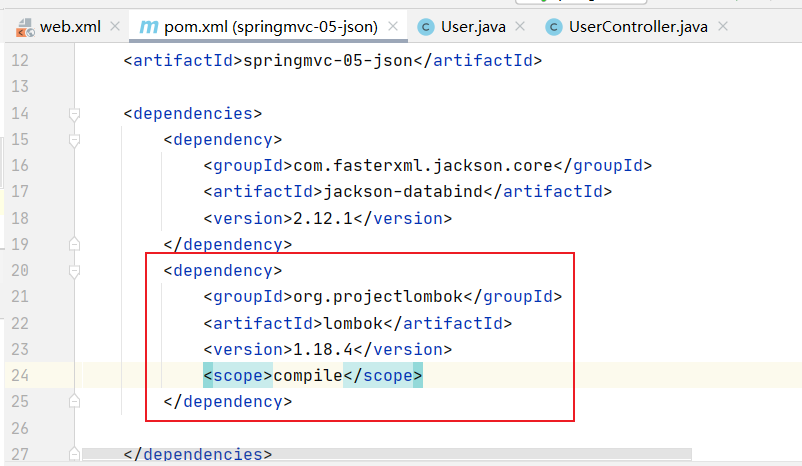
1
2
3
4
5
6
7
8
9
10
11
12
13
14
15
| package com.github.test.pojo;
import lombok.AllArgsConstructor;
import lombok.Data;
import lombok.NoArgsConstructor;
@Data
@AllArgsConstructor
@NoArgsConstructor
public class User {
private String name;
private int age;
private String sex;
}
|
- 编写一个Controller;

1
2
3
4
5
6
7
8
9
10
11
12
13
14
15
16
17
18
19
20
21
22
23
24
| package com.github.test.controller;
import com.fasterxml.jackson.core.JsonProcessingException;
import com.fasterxml.jackson.databind.ObjectMapper;
import com.github.test.pojo.User;
import org.springframework.stereotype.Controller;
import org.springframework.web.bind.annotation.RequestMapping;
import org.springframework.web.bind.annotation.ResponseBody;
@Controller
public class UserController {
@RequestMapping("/j1")
@ResponseBody
public String json1() throws JsonProcessingException {
ObjectMapper mapper = new ObjectMapper();
User user = new User("哇哈哈4号", 22, "man");
String str = mapper.writeValueAsString(user);
return str;
}
}
|
- 配置Tomcat , 启动测试:http://localhost:8080/springmvc_05/j1



- 发现出现了乱码问题,需要设置一下它的编码格式为utf-8,以及它返回的类型;
通过@RequestMaping的produces属性来实现,修改下代码
1
2
|
@RequestMapping(value = "/j1",produces = "application/json;charset=utf-8")
|

- 再次测试,乱码问题解决!

==注意:使用json记得处理乱码问题==。
2.代码优化
- 乱码统一解决
- 上一种方法比较麻烦,如果项目中有许多请求则每一个都要添加,可以通过Spring配置统一指定,这样就不用每次都去处理了!
- 我们可以在springmvc的配置文件上添加一段消息StringHttpMessageConverter转换配置!

1
2
3
4
5
6
7
8
9
10
11
12
13
14
15
|
<mvc:annotation-driven>
<mvc:message-converters register-defaults="true">
<bean class="org.springframework.http.converter.StringHttpMessageConverter">
<constructor-arg value="UTF-8"/>
</bean>
<bean class="org.springframework.http.converter.json.MappingJackson2HttpMessageConverter">
<property name="objectMapper">
<bean class="org.springframework.http.converter.json.Jackson2ObjectMapperFactoryBean">
<property name="failOnEmptyBeans" value="false"/>
</bean>
</property>
</bean>
</mvc:message-converters>
</mvc:annotation-driven>
|
- 返回json字符串统一解决
- 在类上直接使用 @RestController ,这样子,里面所有的方法都只会返回 json 字符串了,不用再每一个都添加@ResponseBody !我们在前后端分离开发中,一般都使用 @RestController ,十分便捷!
1
2
3
4
5
6
7
8
9
10
11
12
13
14
15
16
17
18
19
20
21
22
23
24
25
26
27
| package com.github.test.controller;
import com.fasterxml.jackson.core.JsonProcessingException;
import com.fasterxml.jackson.databind.ObjectMapper;
import com.github.test.pojo.User;
import org.springframework.stereotype.Controller;
import org.springframework.web.bind.annotation.RequestMapping;
import org.springframework.web.bind.annotation.ResponseBody;
import org.springframework.web.bind.annotation.RestController;
@Controller
@RestController
public class UserController {
@ResponseBody
@RequestMapping(value = "/j1")
public String json1() throws JsonProcessingException {
ObjectMapper mapper = new ObjectMapper();
User user = new User("哇哈哈4号", 22, "man");
String str = mapper.writeValueAsString(user);
return str;
}
}
|

3.测试集合输出
- 增加一个新的方法

1
2
3
4
5
6
7
8
9
10
11
12
13
14
15
16
17
18
19
20
| @RequestMapping("/j2")
public String json2() throws JsonProcessingException {
ObjectMapper mapper = new ObjectMapper();
User user = new User("哇哈哈1号", 20, "man");
User user2 = new User("哇哈哈2号", 19, "woman");
User user3 = new User("哇哈哈3号", 22, "man");
User user4 = new User("哇哈哈4号", 21, "woman");
List<User> list = new ArrayList<User>();
list.add(user);
list.add(user2);
list.add(user3);
list.add(user4);
String str = mapper.writeValueAsString(list);
return str;
}
|

4.输出时间对象
1
2
3
4
5
6
7
8
9
10
11
| @RequestMapping("/j3")
public String json3() throws JsonProcessingException {
ObjectMapper mapper = new ObjectMapper();
Date date = new Date();
String str = mapper.writeValueAsString(date);
return str;
}
|

- 默认日期格式会变成一个数字,是1970年1月1日到当前日期的毫秒数!
- Jackson 默认是会把时间转成timestamps形式。
解决方案:取消timestamps形式 , 自定义时间格式。
- 在UserController.java中添加如下代码:
1
2
3
4
5
6
7
8
9
10
11
12
13
14
15
16
| @RequestMapping("/j4")
public String json4() throws JsonProcessingException {
ObjectMapper mapper = new ObjectMapper();
mapper.configure(SerializationFeature.WRITE_DATES_AS_TIMESTAMPS, false);
SimpleDateFormat sdf = new SimpleDateFormat("yyyy-MM-dd HH:mm:ss");
mapper.setDateFormat(sdf);
Date date = new Date();
String str = mapper.writeValueAsString(date);
return str;
}
|

5.抽取上述方法为工具类

1
2
3
4
5
6
7
8
9
10
11
12
13
14
15
16
17
18
19
20
21
22
23
24
25
26
27
28
29
30
| package com.github.test.util;
import com.fasterxml.jackson.core.JsonProcessingException;
import com.fasterxml.jackson.databind.ObjectMapper;
import com.fasterxml.jackson.databind.SerializationFeature;
import java.text.SimpleDateFormat;
public class JsonUtils {
public static String getJson(Object object) {
return getJson(object,"yyyy-MM-dd HH:mm:ss");
}
public static String getJson(Object object,String dateFormat) {
ObjectMapper mapper = new ObjectMapper();
mapper.configure(SerializationFeature.WRITE_DATES_AS_TIMESTAMPS, false);
SimpleDateFormat sdf = new SimpleDateFormat(dateFormat);
mapper.setDateFormat(sdf);
try {
return mapper.writeValueAsString(object);
} catch (JsonProcessingException e) {
e.printStackTrace();
}
return null;
}
}
|
1
2
3
4
5
6
| @RequestMapping("/j5")
public String json5() throws JsonProcessingException {
Date date = new Date();
String json = JsonUtils.getJson(date);
return json;
}
|

4.FastJson
fastjson.jar是阿里开发的一款专门用于Java开发的包,可以方便的实现json对象与JavaBean对象的转换,实现JavaBean对象与json字符串的转换,实现json对象与json字符串的转换。实现json的转换方法很多,最后的实现结果都是一样的。

1
2
3
4
5
6
|
<dependency>
<groupId>com.alibaba</groupId>
<artifactId>fastjson</artifactId>
<version>1.2.75</version>
</dependency>
|
fastjson 三个主要的类:
JSONObject 代表 json 对象
- JSONObject实现了Map接口, 猜想 JSONObject底层操作是由Map实现的。
- JSONObject对应json对象,通过各种形式的get()方法可以获取json对象中的数据,也可利用诸如size(),isEmpty()等方法获取”键:值”对的个数和判断是否为空。其本质是通过实现Map接口并调用接口中的方法完成的。
JSONArray 代表 json 对象数组
JSON代表 JSONObject和JSONArray的转化
- JSON类源码分析与使用
- 仔细观察这些方法,主要是实现json对象,json对象数组,javabean对象,json字符串之间的相互转化。
代码测试,新建一个FastJsonDemo 类。
1
2
3
4
5
6
7
8
9
10
11
12
13
14
15
16
17
18
19
20
21
22
23
24
25
26
27
28
29
30
31
32
33
34
35
36
37
38
39
40
41
| package com.github.test.controller;
import com.alibaba.fastjson.JSON;
import com.alibaba.fastjson.JSONObject;
import com.github.test.pojo.User;
import java.util.ArrayList;
import java.util.List;
public class FastJsonDemo {
public static void main(String[] args) {
User user = new User("哇哈哈1号", 20, "man");
User user2 = new User("哇哈哈2号", 19, "woman");
User user3 = new User("哇哈哈3号", 22, "man");
User user4 = new User("哇哈哈4号", 21, "woman");
List<User> list = new ArrayList<User>();
list.add(user);
list.add(user2);
list.add(user3);
list.add(user4);
System.out.println("*******Java对象 转 JSON字符串*******");
String str1 = JSON.toJSONString(list);
System.out.println("JSON.toJSONString(list)==>"+str1);
String str2 = JSON.toJSONString(user);
System.out.println("JSON.toJSONString(user1)==>"+str2);
System.out.println("\n****** JSON字符串 转 Java对象*******");
User jp_user1=JSON.parseObject(str2,User.class);
System.out.println("JSON.parseObject(str2,User.class)==>"+jp_user1);
System.out.println("\n****** Java对象 转 JSON对象 ******");
JSONObject jsonObject1 = (JSONObject) JSON.toJSON(user2);
System.out.println("(JSONObject) JSON.toJSON(user2)==>"+jsonObject1.getString("name"));
System.out.println("\n****** JSON对象 转 Java对象 ******");
User to_java_user = JSON.toJavaObject(jsonObject1, User.class);
System.out.println("JSON.toJavaObject(jsonObject1, User.class)==>"+to_java_user);
}
}
|

这种工具类,只需要掌握使用就好了,在使用的时候在根据具体的业务去找对应的实现。
7、整合SSM框架
环境要求:
- IDEA 2020.2
- MySQL 5.7.19
- Tomcat 8.5
- Maven 3.6
技术要求:
- 需要熟练掌握MySQL数据库,Spring,JavaWeb及MyBatis知识,简单的前端知识;
数据库环境:
创建一个存放书籍数据的数据库表:
1
2
3
4
5
6
7
8
9
10
11
12
13
14
15
16
17
18
| CREATE DATABASE `ssmbuild`;
USE `ssmbuild`;
DROP TABLE
IF
EXISTS `books`;
CREATE TABLE `books` (
`bookID` INT ( 10 ) NOT NULL AUTO_INCREMENT COMMENT '书id',
`bookName` VARCHAR ( 100 ) NOT NULL COMMENT '书名',
`bookCounts` INT ( 11 ) NOT NULL COMMENT '数量',
`detail` VARCHAR ( 200 ) NOT NULL COMMENT '描述',
KEY `bookID` ( `bookID` )
) ENGINE = INNODB DEFAULT CHARSET = utf8;
INSERT INTO `books` ( `bookID`, `bookName`, `bookCounts`, `detail` )
VALUES
( 1, 'Java', 1, '从入门到放弃' ),
( 2, 'MySQL', 10, '从删库到跑路' ),
( 3, 'Linux', 5, '从进门到进牢' );
|
1.基本环境搭建
- 新建一Maven项目!ssmbuild , 添加web的支持

- 导入相关的pom依赖!
1
2
3
4
5
6
7
8
9
10
11
12
13
14
15
16
17
18
19
20
21
22
23
24
25
26
27
28
29
30
31
32
33
34
35
36
37
38
39
40
41
42
43
44
45
46
47
48
49
50
51
52
53
54
55
56
57
58
59
60
61
| <dependencies>
<dependency>
<groupId>junit</groupId>
<artifactId>junit</artifactId>
<version>4.12</version>
</dependency>
<dependency>
<groupId>mysql</groupId>
<artifactId>mysql-connector-java</artifactId>
<version>5.1.47</version>
</dependency>
<dependency>
<groupId>com.mchange</groupId>
<artifactId>c3p0</artifactId>
<version>0.9.5.2</version>
</dependency>
<dependency>
<groupId>javax.servlet</groupId>
<artifactId>servlet-api</artifactId>
<version>2.5</version>
</dependency>
<dependency>
<groupId>javax.servlet.jsp</groupId>
<artifactId>jsp-api</artifactId>
<version>2.2</version>
</dependency>
<dependency>
<groupId>javax.servlet</groupId>
<artifactId>jstl</artifactId>
<version>1.2</version>
</dependency>
<dependency>
<groupId>org.mybatis</groupId>
<artifactId>mybatis</artifactId>
<version>3.5.2</version>
</dependency>
<dependency>
<groupId>org.mybatis</groupId>
<artifactId>mybatis-spring</artifactId>
<version>2.0.2</version>
</dependency>
<dependency>
<groupId>org.springframework</groupId>
<artifactId>spring-webmvc</artifactId>
<version>5.1.9.RELEASE</version>
</dependency>
<dependency>
<groupId>org.springframework</groupId>
<artifactId>spring-jdbc</artifactId>
<version>5.1.9.RELEASE</version>
</dependency>
</dependencies>
|
- Maven资源过滤设置
1
2
3
4
5
6
7
8
9
10
11
12
13
14
15
16
17
18
19
20
| <build>
<resources>
<resource>
<directory>src/main/java</directory>
<includes>
<include>**/*.properties</include>
<include>**/*.xml</include>
</includes>
<filtering>false</filtering>
</resource>
<resource>
<directory>src/main/resources</directory>
<includes>
<include>**/*.properties</include>
<include>**/*.xml</include>
</includes>
<filtering>false</filtering>
</resource>
</resources>
</build>
|
- 建立基本结构和配置框架!
- com.github.test.pojo
- com.github.test.dao
- com.github.test.service
- com.github.test.controller
- mybatis-config.xml

1
2
3
4
5
6
7
| <?xml version="1.0" encoding="UTF-8" ?>
<!DOCTYPE configuration
PUBLIC "-//mybatis.org//DTD Config 3.0//EN"
"http://mybatis.org/dtd/mybatis-3-config.dtd">
<configuration>
</configuration>
|
1
2
3
4
5
6
7
| <?xml version="1.0" encoding="UTF-8"?>
<beans xmlns="http://www.springframework.org/schema/beans"
xmlns:xsi="http://www.w3.org/2001/XMLSchema-instance"
xsi:schemaLocation="http://www.springframework.org/schema/beans
http://www.springframework.org/schema/beans/spring-beans.xsd">
</beans>
|
2.Mybatis层
- 数据库配置文件 database.properties

1
2
3
4
5
| jdbc.driver=com.mysql.jdbc.Driver
# 如果使用的是MySQL8.0+,增加一个时区的配置。
jdbc.url=jdbc:mysql://localhost:3306/ssmbuild?useSSL=true&useUnicode=true&characterEncoding=utf8
jdbc.username=root
jdbc.password=root
|
- IDEA关联数据库

- 编写MyBatis的核心配置文件
1
2
3
4
5
6
7
8
9
10
11
12
13
14
15
| <?xml version="1.0" encoding="UTF-8" ?>
<!DOCTYPE configuration
PUBLIC "-//mybatis.org//DTD Config 3.0//EN"
"http://mybatis.org/dtd/mybatis-3-config.dtd">
<configuration>
<typeAliases>
<package name="com.github.test.pojo"/>
</typeAliases>
<mappers>
<mapper class="com.github.test.dao.BookMapper"/>
</mappers>
</configuration>
|
- 编写数据库对应的实体类 com.github.test.pojo.Books,使用lombok插件!
1
2
3
4
5
6
7
8
9
10
11
12
13
14
15
16
| package com.github.test.pojo;
import lombok.AllArgsConstructor;
import lombok.Data;
import lombok.NoArgsConstructor;
@Data
@AllArgsConstructor
@NoArgsConstructor
public class Books {
private int bookID;
private String bookName;
private int bookCounts;
private String detail;
}
|
- 编写Dao层的 Mapper接口!
1
2
3
4
5
6
7
8
9
10
11
12
13
14
15
16
17
18
19
20
21
22
23
| package com.github.test.dao;
import com.github.test.pojo.Books;
import org.apache.ibatis.annotations.Param;
import java.util.List;
public interface BookMapper {
int addBook(Books book);
int deleteBookById(@Param("bookID") int id);
int updateBook(Books books);
Books queryBookById(@Param("bookID") int id);
List<Books> queryAllBook();
}
|
- 编写接口对应的Mapper.xml 文件。需要导入MyBatis的包;

1
2
3
4
5
6
7
8
9
10
11
12
13
14
15
16
17
18
19
20
21
22
23
24
25
26
27
28
29
30
31
32
33
34
35
36
37
| <?xml version="1.0" encoding="UTF-8" ?>
<!DOCTYPE mapper
PUBLIC "-//mybatis.org//DTD Mapper 3.0//EN"
"http://mybatis.org/dtd/mybatis-3-mapper.dtd">
<mapper namespace="com.github.test.dao.BookMapper">
<insert id="addBook" parameterType="Books">
insert into ssmbuild.books(bookName,bookCounts,detail)
values (#{bookName}, #{bookCounts}, #{detail});
</insert>
<delete id="deleteBookById" parameterType="int">
delete from ssmbuild.books where bookID=#{bookID};
</delete>
<update id="updateBook" parameterType="Books">
update ssmbuild.books
set bookName = #{bookName},bookCounts = #{bookCounts},detail = #{detail}
where bookID = #{bookID};
</update>
<select id="queryBookById" resultType="Books">
select * from ssmbuild.books
where bookID = #{bookID};
</select>
<select id="queryAllBook" resultType="Books">
SELECT * from ssmbuild.books;
</select>
</mapper>
|
- 编写Service层的接口和实现类
1
2
3
4
5
6
7
8
9
10
11
12
13
14
15
16
17
18
19
| package com.github.test.service;
import com.github.test.pojo.Books;
import java.util.List;
public interface BookService {
int addBook(Books book);
int deleteBookById(int id);
int updateBook(Books books);
Books queryBookById(int id);
List<Books> queryAllBook();
}
|
1
2
3
4
5
6
7
8
9
10
11
12
13
14
15
16
17
18
19
20
21
22
23
24
25
26
27
28
29
30
31
32
33
34
35
36
| package com.github.test.service;
import com.github.test.dao.BookMapper;
import com.github.test.pojo.Books;
import java.util.List;
public class BookServiceImpl implements BookService {
private BookMapper bookMapper;
public void setBookMapper(BookMapper bookMapper) {
this.bookMapper = bookMapper;
}
public int addBook(Books book) {
return bookMapper.addBook(book);
}
public int deleteBookById(int id) {
return bookMapper.deleteBookById(id);
}
public int updateBook(Books books) {
return bookMapper.updateBook(books);
}
public Books queryBookById(int id) {
return bookMapper.queryBookById(id);
}
public List<Books> queryAllBook() {
return bookMapper.queryAllBook();
}
}
|
OK,到此,底层需求操作编写完毕!
3.Spring层
配置Spring整合MyBatis,这里数据源使用c3p0连接池;
编写Spring整合Mybatis的相关的配置文件;spring-dao.xml
1
2
3
4
5
6
7
8
9
10
11
12
13
14
15
16
17
18
19
20
21
22
23
24
25
26
27
28
29
30
31
32
33
34
35
36
37
38
39
40
41
42
43
44
45
46
47
48
49
50
51
52
53
54
| <?xml version="1.0" encoding="UTF-8"?>
<beans xmlns="http://www.springframework.org/schema/beans"
xmlns:xsi="http://www.w3.org/2001/XMLSchema-instance"
xmlns:context="http://www.springframework.org/schema/context"
xsi:schemaLocation="http://www.springframework.org/schema/beans
http://www.springframework.org/schema/beans/spring-beans.xsd
http://www.springframework.org/schema/context
https://www.springframework.org/schema/context/spring-context.xsd">
<context:property-placeholder location="classpath:database.properties"/>
<bean id="dataSource" class="com.mchange.v2.c3p0.ComboPooledDataSource">
<property name="driverClass" value="${jdbc.driver}"/>
<property name="jdbcUrl" value="${jdbc.url}"/>
<property name="user" value="${jdbc.username}"/>
<property name="password" value="${jdbc.password}"/>
<property name="maxPoolSize" value="30"/>
<property name="minPoolSize" value="10"/>
<property name="autoCommitOnClose" value="false"/>
<property name="checkoutTimeout" value="10000"/>
<property name="acquireRetryAttempts" value="2"/>
</bean>
<bean id="sqlSessionFactory" class="org.mybatis.spring.SqlSessionFactoryBean">
<property name="dataSource" ref="dataSource"/>
<property name="configLocation" value="classpath:mybatis-config.xml"/>
</bean>
<bean class="org.mybatis.spring.mapper.MapperScannerConfigurer">
<property name="sqlSessionFactoryBeanName" value="sqlSessionFactory"/>
<property name="basePackage" value="com.github.test.dao"/>
</bean>
</beans>
|
- Spring整合service层
1
2
3
4
5
6
7
8
9
10
11
12
13
14
15
16
17
18
19
20
21
22
23
24
| <?xml version="1.0" encoding="UTF-8"?>
<beans xmlns="http://www.springframework.org/schema/beans"
xmlns:xsi="http://www.w3.org/2001/XMLSchema-instance"
xmlns:context="http://www.springframework.org/schema/context"
xsi:schemaLocation="http://www.springframework.org/schema/beans
http://www.springframework.org/schema/beans/spring-beans.xsd
http://www.springframework.org/schema/context
http://www.springframework.org/schema/context/spring-context.xsd">
<context:component-scan base-package="com.github.test.service" />
<bean id="BookServiceImpl" class="com.github.test.service.BookServiceImpl">
<property name="bookMapper" ref="bookMapper"/>
</bean>
<bean id="transactionManager" class="org.springframework.jdbc.datasource.DataSourceTransactionManager">
<property name="dataSource" ref="dataSource" />
</bean>
</beans>
|
4.SpringMVC层
- web.xml
1
2
3
4
5
6
7
8
9
10
11
12
13
14
15
16
17
18
19
20
21
22
23
24
25
26
27
28
29
30
31
32
33
34
35
36
37
38
39
40
41
42
43
44
| <?xml version="1.0" encoding="UTF-8"?>
<web-app xmlns="http://xmlns.jcp.org/xml/ns/javaee"
xmlns:xsi="http://www.w3.org/2001/XMLSchema-instance"
xsi:schemaLocation="http://xmlns.jcp.org/xml/ns/javaee http://xmlns.jcp.org/xml/ns/javaee/web-app_4_0.xsd"
version="4.0">
<servlet>
<servlet-name>DispatcherServlet</servlet-name>
<servlet-class>org.springframework.web.servlet.DispatcherServlet</servlet-class>
<init-param>
<param-name>contextConfigLocation</param-name>
<param-value>classpath:applicationContext.xml</param-value>
</init-param>
<load-on-startup>1</load-on-startup>
</servlet>
<servlet-mapping>
<servlet-name>DispatcherServlet</servlet-name>
<url-pattern>/</url-pattern>
</servlet-mapping>
<filter>
<filter-name>encodingFilter</filter-name>
<filter-class>
org.springframework.web.filter.CharacterEncodingFilter
</filter-class>
<init-param>
<param-name>encoding</param-name>
<param-value>utf-8</param-value>
</init-param>
</filter>
<filter-mapping>
<filter-name>encodingFilter</filter-name>
<url-pattern>/*</url-pattern>
</filter-mapping>
<session-config>
<session-timeout>15</session-timeout>
</session-config>
</web-app>
|
- spring-mvc.xml
1
2
3
4
5
6
7
8
9
10
11
12
13
14
15
16
17
18
19
20
21
22
23
24
25
26
27
28
29
| <?xml version="1.0" encoding="UTF-8"?>
<beans xmlns="http://www.springframework.org/schema/beans"
xmlns:xsi="http://www.w3.org/2001/XMLSchema-instance"
xmlns:context="http://www.springframework.org/schema/context"
xmlns:mvc="http://www.springframework.org/schema/mvc"
xsi:schemaLocation="http://www.springframework.org/schema/beans
http://www.springframework.org/schema/beans/spring-beans.xsd
http://www.springframework.org/schema/context
http://www.springframework.org/schema/context/spring-context.xsd
http://www.springframework.org/schema/mvc
https://www.springframework.org/schema/mvc/spring-mvc.xsd">
<mvc:annotation-driven />
<mvc:default-servlet-handler/>
<bean class="org.springframework.web.servlet.view.InternalResourceViewResolver">
<property name="viewClass" value="org.springframework.web.servlet.view.JstlView" />
<property name="prefix" value="/WEB-INF/jsp/" />
<property name="suffix" value=".jsp" />
</bean>
<context:component-scan base-package="com.github.test.controller" />
</beans>
|
- Spring配置整合文件,applicationContext.xml
1
2
3
4
5
6
7
8
9
10
11
| <?xml version="1.0" encoding="UTF-8"?>
<beans xmlns="http://www.springframework.org/schema/beans"
xmlns:xsi="http://www.w3.org/2001/XMLSchema-instance"
xsi:schemaLocation="http://www.springframework.org/schema/beans
http://www.springframework.org/schema/beans/spring-beans.xsd">
<import resource="spring-dao.xml"/>
<import resource="spring-service.xml"/>
<import resource="spring-mvc.xml"/>
</beans>
|
配置文件,暂时结束!Controller 和 视图层编写
5.案例实现
- BookController 类编写 , 方法一:查询全部书籍
1
2
3
4
5
6
7
8
9
10
11
12
13
14
15
16
17
18
19
20
21
22
23
24
25
26
27
| package com.github.test.controller;
import com.github.test.pojo.Books;
import com.github.test.service.BookService;
import org.springframework.beans.factory.annotation.Autowired;
import org.springframework.beans.factory.annotation.Qualifier;
import org.springframework.stereotype.Controller;
import org.springframework.ui.Model;
import org.springframework.web.bind.annotation.RequestMapping;
import java.util.List;
@Controller
@RequestMapping("/book")
public class BookController {
@Autowired
@Qualifier("BookServiceImpl")
private BookService bookService;
@RequestMapping("/allBook")
public String list(Model model) {
List<Books> list = bookService.queryAllBook();
model.addAttribute("list", list);
return "allBook";
}
}
|
2、编写首页 index.jsp
1
2
3
4
5
6
7
8
9
10
11
12
13
14
15
16
17
18
19
20
21
22
23
24
25
26
27
28
29
| <%@ page language="java" contentType="text/html; charset=UTF-8" pageEncoding="UTF-8" %>
<!DOCTYPE HTML>
<html>
<head>
<title>首页</title>
<style type="text/css">
a {
text-decoration: none;
color: black;
font-size: 18px;
}
h3 {
width: 180px;
height: 38px;
margin: 100px auto;
text-align: center;
line-height: 38px;
background: deepskyblue;
border-radius: 4px;
}
</style>
</head>
<body>
<h3>
<a href="${pageContext.request.contextPath}/book/allBook">点击进入列表页</a>
</h3>
</body>
</html>
|
- 书籍列表页面 allbook.jsp
1
2
3
4
5
6
7
8
9
10
11
12
13
14
15
16
17
18
19
20
21
22
23
24
25
26
27
28
29
30
31
32
33
34
35
36
37
38
39
40
41
42
43
44
45
46
47
48
49
50
51
52
53
54
55
56
57
58
59
60
| <%@ taglib prefix="c" uri="http://java.sun.com/jsp/jstl/core" %>
<%@ page contentType="text/html;charset=UTF-8" language="java" %>
<html>
<head>
<title>书籍列表</title>
<meta name="viewport" content="width=device-width, initial-scale=1.0">
<!-- 引入 Bootstrap -->
<link href="https://cdn.bootcss.com/bootstrap/3.3.7/css/bootstrap.min.css" rel="stylesheet">
</head>
<body>
<div class="container">
<div class="row clearfix">
<div class="col-md-12 column">
<div class="page-header">
<h1>
<small>书籍列表 —— 显示所有书籍</small>
</h1>
</div>
</div>
</div>
<div class="row">
<div class="col-md-4 column">
<a class="btn btn-primary" href="${pageContext.request.contextPath}/book/toAddBook">新增书籍</a>
</div>
</div>
<div class="row clearfix">
<div class="col-md-12 column">
<table class="table table-hover table-striped">
<thead>
<tr>
<th>书籍编号</th>
<th>书籍名字</th>
<th>书籍数量</th>
<th>书籍详情</th>
<th>操作</th>
</tr>
</thead>
<tbody>
<c:forEach var="book" items="${requestScope.get('list')}">
<tr>
<td>${book.getBookID()}</td>
<td>${book.getBookName()}</td>
<td>${book.getBookCounts()}</td>
<td>${book.getDetail()}</td>
<td>
<a href="${pageContext.request.contextPath}/book/toUpdateBook?id=${book.getBookID()}">更改</a> |
<a href="${pageContext.request.contextPath}/book/del/${book.getBookID()}">删除</a>
</td>
</tr>
</c:forEach>
</tbody>
</table>
</div>
</div>
</div>
|
- BookController 类编写 , 方法二:添加书籍
1
2
3
4
5
6
7
8
9
10
11
| @RequestMapping("/toAddBook")
public String toAddPaper() {
return "addBook";
}
@RequestMapping("/addBook")
public String addPaper(Books books) {
System.out.println(books);
bookService.addBook(books);
return "redirect:/book/allBook";
}
|
- 添加书籍页面:addBook.jsp
1
2
3
4
5
6
7
8
9
10
11
12
13
14
15
16
17
18
19
20
21
22
23
24
25
26
27
28
29
30
| <%@ taglib prefix="c" uri="http://java.sun.com/jsp/jstl/core" %>
<%@ page contentType="text/html;charset=UTF-8" language="java" %>
<html>
<head>
<title>新增书籍</title>
<meta name="viewport" content="width=device-width, initial-scale=1.0">
<!-- 引入 Bootstrap -->
<link href="https://cdn.bootcss.com/bootstrap/3.3.7/css/bootstrap.min.css" rel="stylesheet">
</head>
<body>
<div class="container">
<div class="row clearfix">
<div class="col-md-12 column">
<div class="page-header">
<h1>
<small>新增书籍</small>
</h1>
</div>
</div>
</div>
<form action="${pageContext.request.contextPath}/book/addBook" method="post">
书籍名称:<input type="text" name="bookName"><br><br><br>
书籍数量:<input type="text" name="bookCounts"><br><br><br>
书籍详情:<input type="text" name="detail"><br><br><br>
<input type="submit" value="添加">
</form>
</div>
|
- BookController 类编写 , 方法三:修改书籍
1
2
3
4
5
6
7
8
9
10
11
12
13
14
15
16
| @RequestMapping("/toUpdateBook")
public String toUpdateBook(Model model, int id) {
Books books = bookService.queryBookById(id);
System.out.println(books);
model.addAttribute("book",books );
return "updateBook";
}
@RequestMapping("/updateBook")
public String updateBook(Model model, Books book) {
System.out.println(book);
bookService.updateBook(book);
Books books = bookService.queryBookById(book.getBookID());
model.addAttribute("books", books);
return "redirect:/book/allBook";
}
|
- 修改书籍页面 updateBook.jsp
1
2
3
4
5
6
7
8
9
10
11
12
13
14
15
16
17
18
19
20
21
22
23
24
25
26
27
28
29
30
31
32
33
34
35
36
37
38
| <%--
Created by IntelliJ IDEA.
User: test
Date: 2021/2/27
Time: 17:53
To change this template use File | Settings | File Templates.
--%>
<%@ taglib prefix="c" uri="http://java.sun.com/jsp/jstl/core" %>
<%@ page contentType="text/html;charset=UTF-8" language="java" %>
<html>
<head>
<title>修改信息</title>
<meta name="viewport" content="width=device-width, initial-scale=1.0">
<!-- 引入 Bootstrap -->
<link href="https://cdn.bootcss.com/bootstrap/3.3.7/css/bootstrap.min.css" rel="stylesheet">
</head>
<body>
<div class="container">
<div class="row clearfix">
<div class="col-md-12 column">
<div class="page-header">
<h1>
<small>修改信息</small>
</h1>
</div>
</div>
</div>
<form action="${pageContext.request.contextPath}/book/updateBook" method="post">
<input type="hidden" name="bookID" value="${book.getBookID()}"/>
书籍名称:<input type="text" name="bookName" value="${book.getBookName()}"/>
书籍数量:<input type="text" name="bookCounts" value="${book.getBookCounts()}"/>
书籍详情:<input type="text" name="detail" value="${book.getDetail() }"/>
<input type="submit" value="提交"/>
</form>
</div>
|
- BookController 类编写 , 方法四:删除书籍
1
2
3
4
5
| @RequestMapping("/del/{bookID}")
public String deleteBook(@PathVariable("bookID") int id) {
bookService.deleteBookById(id);
return "redirect:/book/allBook";
}
|
- 书籍查询功能

1
2
3
4
5
6
7
8
| <div class="col-md-4 column"></div>
<div class="form-inline">
<%-- 查询书籍 --%>
<form action="" method="" style="float: right">
<input type="text" name="queryBookName" class="form-control" placeholder="请输入需要查询的书籍名">
<input type="submit" value="查询" class="btn btn-primary">
</form>
</div>
|
1
2
|
Books queryBookByName(@Param("bookName")String bookName);
|
1
2
3
4
|
<select id="queryBookByName" resultType="Books">
SELECT * from ssmbuild.books where bookName = #{bookName};
</select>
|
- 修改service层:BookService.java
1
2
|
Books queryBookByName(String bookName);
|
- 修改service层:BookServiceImpl.java
1
2
3
| public Books queryBookByName(String bookName) {
return bookMapper.queryBookByName(bookName);
}
|
- 修改controller层:BookController.java
1
2
3
4
5
6
7
8
9
|
@RequestMapping("/queryBook")
public String queryBook(String queryBookName,Model model){
Books books = bookService.queryBookByName(queryBookName);
List<Books> list = new ArrayList<Books>();
list.add(books);
model.addAttribute("list", list);
return "allBook";
}
|

1
2
3
4
5
6
7
8
| <div class="col-md-4 column"></div>
<div class="form-inline">
<%-- 查询书籍 --%>
<form action="${pageContext.request.contextPath}/book/queryBook" method="post" style="float: right">
<input type="text" name="queryBookName" class="form-control" placeholder="请输入需要查询的书籍名">
<input type="submit" value="查询" class="btn btn-primary">
</form>
</div>
|


如果查询失败,需要显示全部书籍页面?

1
2
3
4
5
6
7
8
9
10
11
12
13
14
15
| <div class="row">
<div class="col-md-4 column">
<a class="btn btn-primary" href="${pageContext.request.contextPath}/book/toAddBook">新增书籍</a>
<a class="btn btn-primary" href="${pageContext.request.contextPath}/book/allBook">显示全部书籍</a>
</div>
<div class="col-md-4 column"></div>
<div class="form-inline">
<%-- 查询书籍 --%>
<form action="${pageContext.request.contextPath}/book/queryBook" method="post" style="float: right">
<span style="color: red;font-weight: bold" >${error}</span>
<input type="text" name="queryBookName" class="form-control" placeholder="请输入需要查询的书籍名">
<input type="submit" value="查询" class="btn btn-primary">
</form>
</div>
</div>
|
1
2
3
4
5
6
7
8
9
10
11
12
13
14
15
|
@RequestMapping("/queryBook")
public String queryBook(String queryBookName,Model model){
Books books = bookService.queryBookByName(queryBookName);
List<Books> list = new ArrayList<Books>();
list.add(books);
if(books==null){
list = bookService.queryAllBook();
model.addAttribute("error","未查到");
}
model.addAttribute("list", list);
return "allBook";
}
|


配置Tomcat,进行运行!





项目结构图:


推荐一个前端可视化布局设计网站:https://www.bootcss.com/p/layoutit/

8、Ajax技术
1.Ajax初体验
简介
AJAX = Asynchronous JavaScript and XML(异步的 JavaScript 和 XML)。
AJAX 是一种在无需重新加载整个网页的情况下,能够更新部分网页的技术。
Ajax 不是一种新的编程语言,而是一种用于创建更好更快以及交互性更强的Web应用程序的技术。
在 2005 年,Google 通过其 Google Suggest 使 AJAX 变得流行起来。Google Suggest能够自动帮你完成搜索单词。
Google Suggest 使用 AJAX 创造出动态性极强的 web 界面:当您在谷歌的搜索框输入关键字时,JavaScript 会把这些字符发送到服务器,然后服务器会返回一个搜索建议的列表。
和国内百度的搜索框一样!
传统的网页(即不用ajax技术的网页),想要更新内容或者提交一个表单,都需要重新加载整个网页。
使用ajax技术的网页,通过在后台服务器进行少量的数据交换,就可以实现异步局部更新。
使用Ajax,用户可以创建接近本地桌面应用的直接、高可用、更丰富、更动态的Web用户界面。
伪造Ajax
- 可以使用前端的一个标签来伪造一个ajax的样子。iframe标签
- 新建一个module :springmvc-06-ajax , 导入web支持!

- 测试项目是否成功!
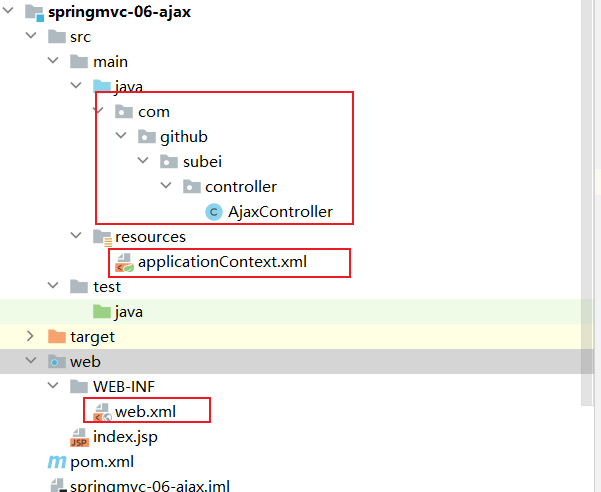
1
2
3
4
5
6
7
8
9
10
11
12
13
14
15
16
17
18
19
20
21
22
23
24
25
26
27
28
29
30
31
32
33
| <?xml version="1.0" encoding="UTF-8"?>
<web-app xmlns="http://xmlns.jcp.org/xml/ns/javaee"
xmlns:xsi="http://www.w3.org/2001/XMLSchema-instance"
xsi:schemaLocation="http://xmlns.jcp.org/xml/ns/javaee http://xmlns.jcp.org/xml/ns/javaee/web-app_4_0.xsd"
version="4.0">
<servlet>
<servlet-name>springmvc</servlet-name>
<servlet-class>org.springframework.web.servlet.DispatcherServlet</servlet-class>
<init-param>
<param-name>contextConfigLocation</param-name>
<param-value>classpath:applicationContext.xml</param-value>
</init-param>
<load-on-startup>1</load-on-startup>
</servlet>
<servlet-mapping>
<servlet-name>springmvc</servlet-name>
<url-pattern>/</url-pattern>
</servlet-mapping>
<filter>
<filter-name>encoding</filter-name>
<filter-class>org.springframework.web.filter.CharacterEncodingFilter</filter-class>
<init-param>
<param-name>encoding</param-name>
<param-value>utf-8</param-value>
</init-param>
</filter>
<filter-mapping>
<filter-name>encoding</filter-name>
<url-pattern>/*</url-pattern>
</filter-mapping>
</web-app>
|
1
2
3
4
5
6
7
8
9
10
11
12
13
14
15
16
17
18
19
20
21
22
23
24
25
26
27
28
29
30
31
32
33
34
35
36
37
38
39
40
41
| <?xml version="1.0" encoding="UTF-8"?>
<beans xmlns="http://www.springframework.org/schema/beans"
xmlns:xsi="http://www.w3.org/2001/XMLSchema-instance"
xmlns:context="http://www.springframework.org/schema/context"
xmlns:mvc="http://www.springframework.org/schema/mvc"
xsi:schemaLocation="http://www.springframework.org/schema/beans
http://www.springframework.org/schema/beans/spring-beans.xsd
http://www.springframework.org/schema/context
https://www.springframework.org/schema/context/spring-context.xsd
http://www.springframework.org/schema/mvc
https://www.springframework.org/schema/mvc/spring-mvc.xsd">
<context:component-scan base-package="com.github.test.controller"/>
<bean class="org.springframework.web.servlet.view.InternalResourceViewResolver"
id="internalResourceViewResolver">
<property name="prefix" value="/WEB-INF/jsp/" />
<property name="suffix" value=".jsp" />
</bean>
<mvc:annotation-driven>
<mvc:message-converters register-defaults="true">
<bean class="org.springframework.http.converter.StringHttpMessageConverter">
<constructor-arg value="UTF-8"/>
</bean>
<bean class="org.springframework.http.converter.json.MappingJackson2HttpMessageConverter">
<property name="objectMapper">
<bean class="org.springframework.http.converter.json.Jackson2ObjectMapperFactoryBean">
<property name="failOnEmptyBeans" value="false"/>
</bean>
</property>
</bean>
</mvc:message-converters>
</mvc:annotation-driven>
</beans>
|
1
2
3
4
5
6
7
8
9
10
11
12
13
| package com.github.test.controller;
import org.springframework.web.bind.annotation.RequestMapping;
import org.springframework.web.bind.annotation.RestController;
@RestController
public class AjaxController {
@RequestMapping("k1")
public String test(){
return "hello";
}
}
|
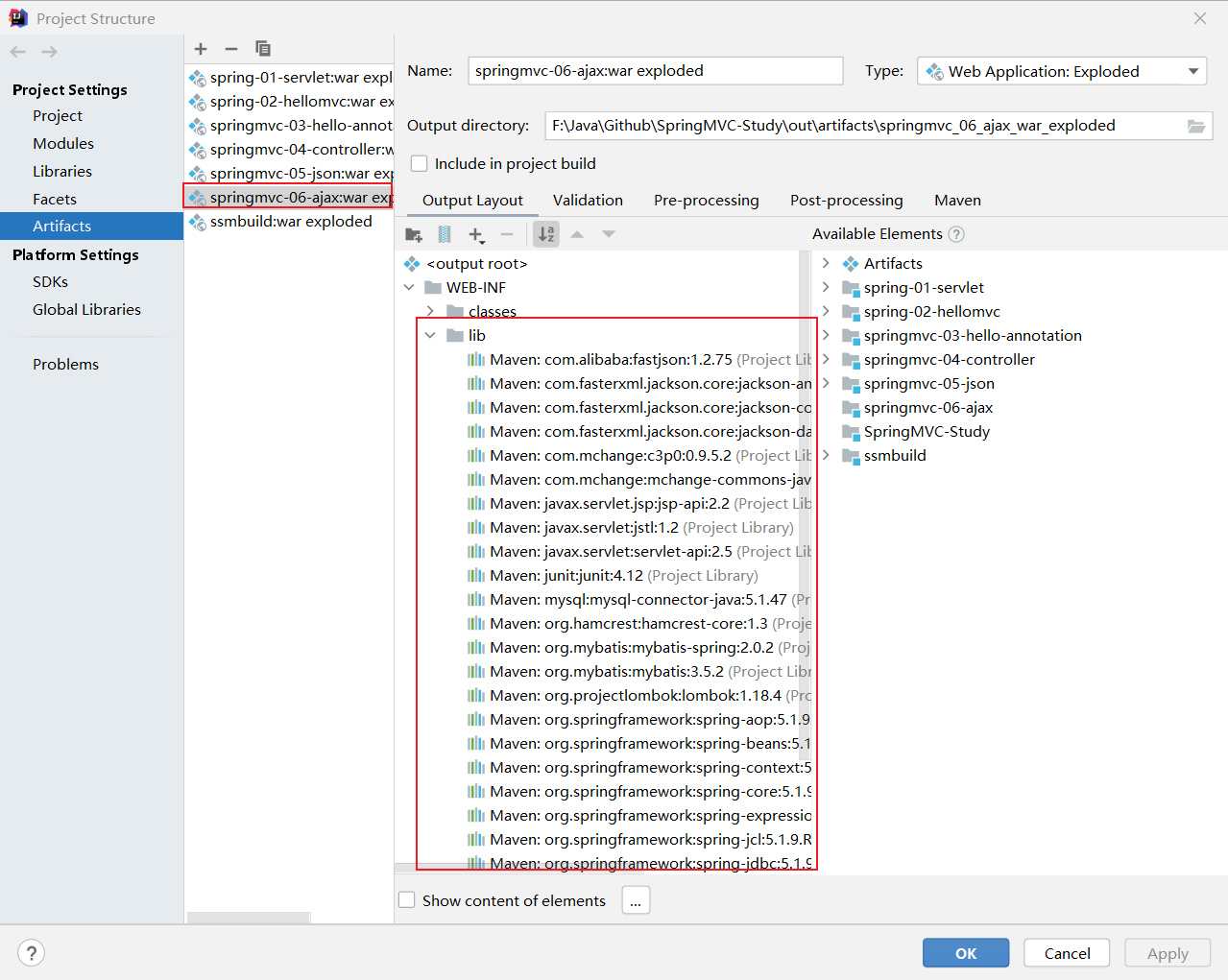
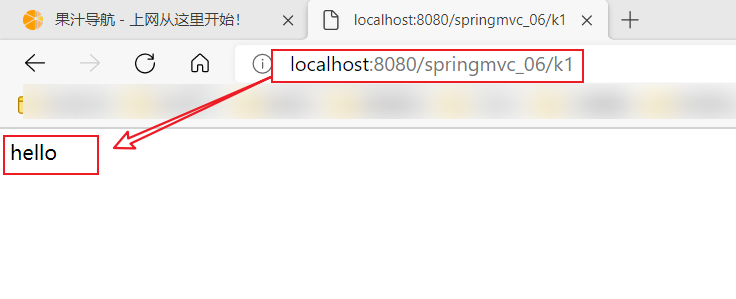
- 编写一个 ajax-frame.html 使用 iframe 测试,感受下效果。
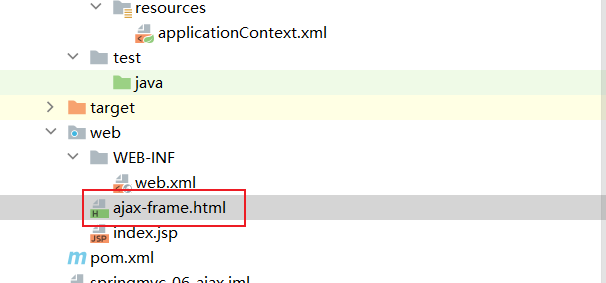
1
2
3
4
5
6
7
8
9
10
11
12
13
14
15
16
17
18
19
20
21
22
23
24
25
26
27
28
29
30
31
32
33
34
35
| <!DOCTYPE html>
<html lang="en">
<head>
<meta charset="UTF-8">
<title>test</title>
</head>
<body>
<script type="text/javascript">
window.onload = function(){
var myDate = new Date();
document.getElementById('currentTime').innerText = myDate.getTime();
};
function LoadPage(){
var targetUrl = document.getElementById('url').value;
console.log(targetUrl);
document.getElementById("iframePosition").src = targetUrl;
}
</script>
<div>
<p>请输入要加载的地址:<span id="currentTime"></span></p>
<p>
<input id="url" type="text" value="https://www.dogedoge.com/"/>
<input type="button" value="提交" onclick="LoadPage()">
</p>
</div>
<div>
<h3>加载页面位置:</h3>
<iframe id="iframePosition" style="width: 100%;height: 500px;"></iframe>
</div>
</body>
</html>
|
- 使用IDEA开浏览器测试一下!
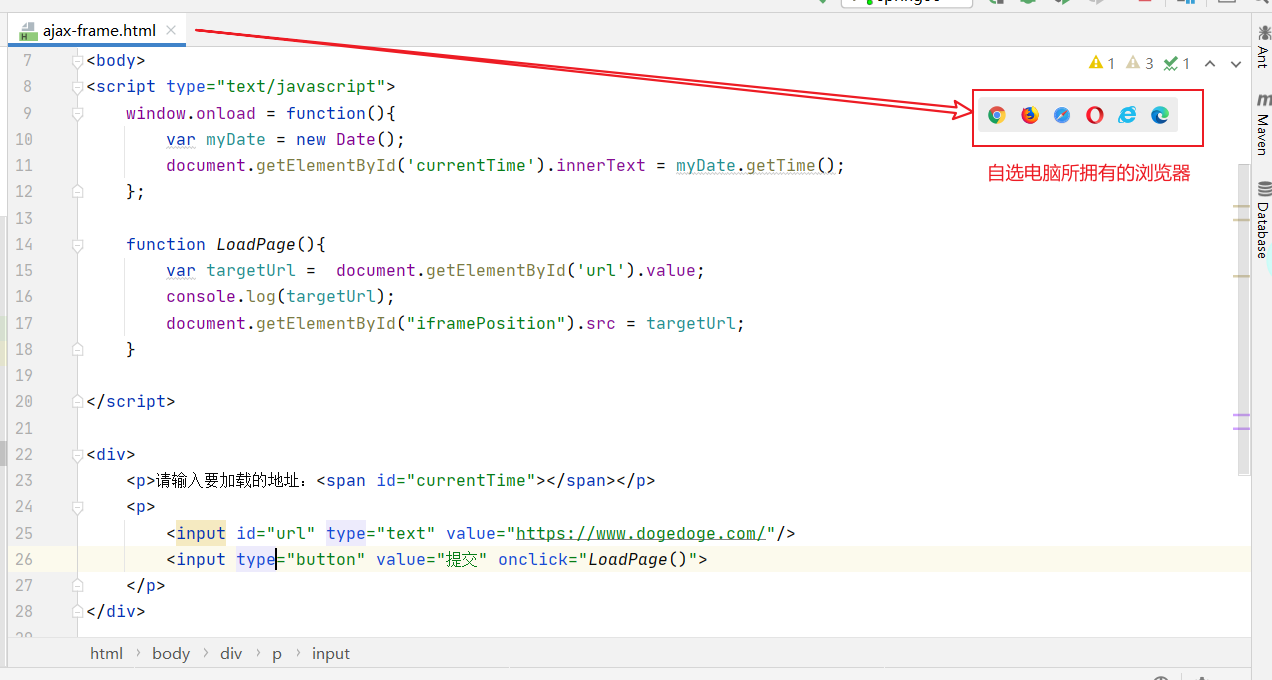
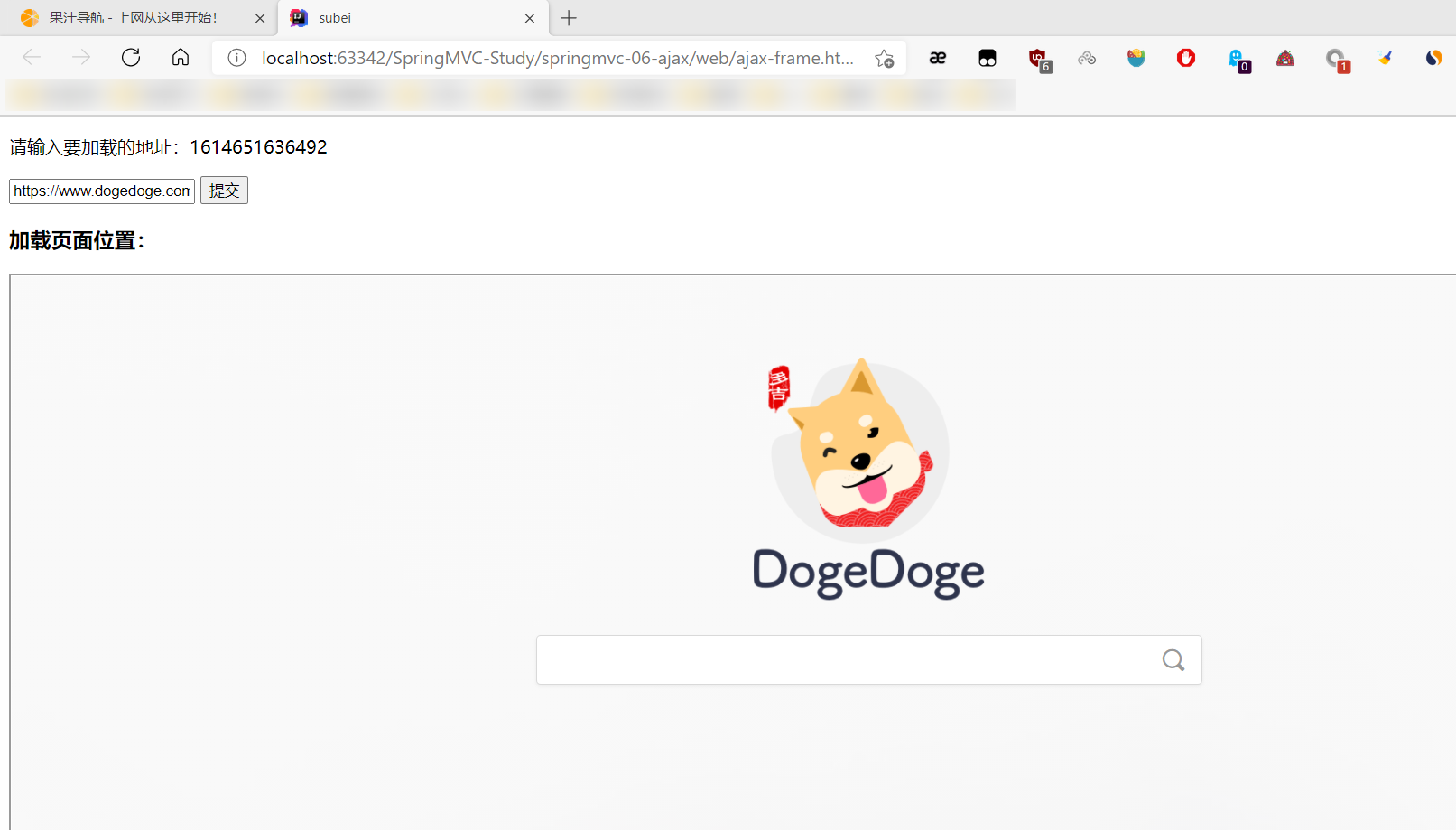
利用AJAX可以做:
- 注册时,输入用户名自动检测用户是否已经存在。
- 登陆时,提示用户名密码错误
- 删除数据行时,将行ID发送到后台,后台在数据库中删除,数据库删除成功后,在页面DOM中将数据行也删除。
- ….等等
2.jQuery
纯JS原生实现Ajax不作详细赘述,直接使用jquery提供的,方便学习和使用,避免重复造轮子,有兴趣的同学可以去了解下==JS原生XMLHttpRequest== !
Ajax的核心是XMLHttpRequest对象(XHR)。XHR为向服务器发送请求和解析服务器响应提供了接口。能够以异步方式从服务器获取新数据。
jQuery 提供多个与 AJAX 有关的方法。
通过 jQuery AJAX 方法,您能够使用 HTTP Get 和 HTTP Post 从远程服务器上请求文本、HTML、XML 或 JSON – 同时您能够把这些外部数据直接载入网页的被选元素中。
jQuery 不是生产者,而是大自然搬运工。
jQuery Ajax本质就是 XMLHttpRequest,对他进行了封装,方便调用!
1
2
3
4
5
6
7
8
9
10
11
12
13
14
15
16
17
18
19
20
21
| jQuery.ajax(...)
部分参数:
url:请求地址
type:请求方式,GET、POST(1.9.0之后用method)
headers:请求头
data:要发送的数据
contentType:即将发送信息至服务器的内容编码类型(默认: "application/x-www-form-urlencoded; charset=UTF-8")
async:是否异步
timeout:设置请求超时时间(毫秒)
beforeSend:发送请求前执行的函数(全局)
complete:完成之后执行的回调函数(全局)
success:成功之后执行的回调函数(全局)
error:失败之后执行的回调函数(全局)
accepts:通过请求头发送给服务器,告诉服务器当前客户端可接受的数据类型
dataType:将服务器端返回的数据转换成指定类型
"xml": 将服务器端返回的内容转换成xml格式
"text": 将服务器端返回的内容转换成普通文本格式
"html": 将服务器端返回的内容转换成普通文本格式,在插入DOM中时,如果包含JavaScript标签,则会尝试去执行。
"script": 尝试将返回值当作JavaScript去执行,然后再将服务器端返回的内容转换成普通文本格式
"json": 将服务器端返回的内容转换成相应的JavaScript对象
"jsonp": JSONP 格式使用 JSONP 形式调用函数时,如 "myurl?callback=?" jQuery 将自动替换 ? 为正确的函数名,以执行回调函数
|
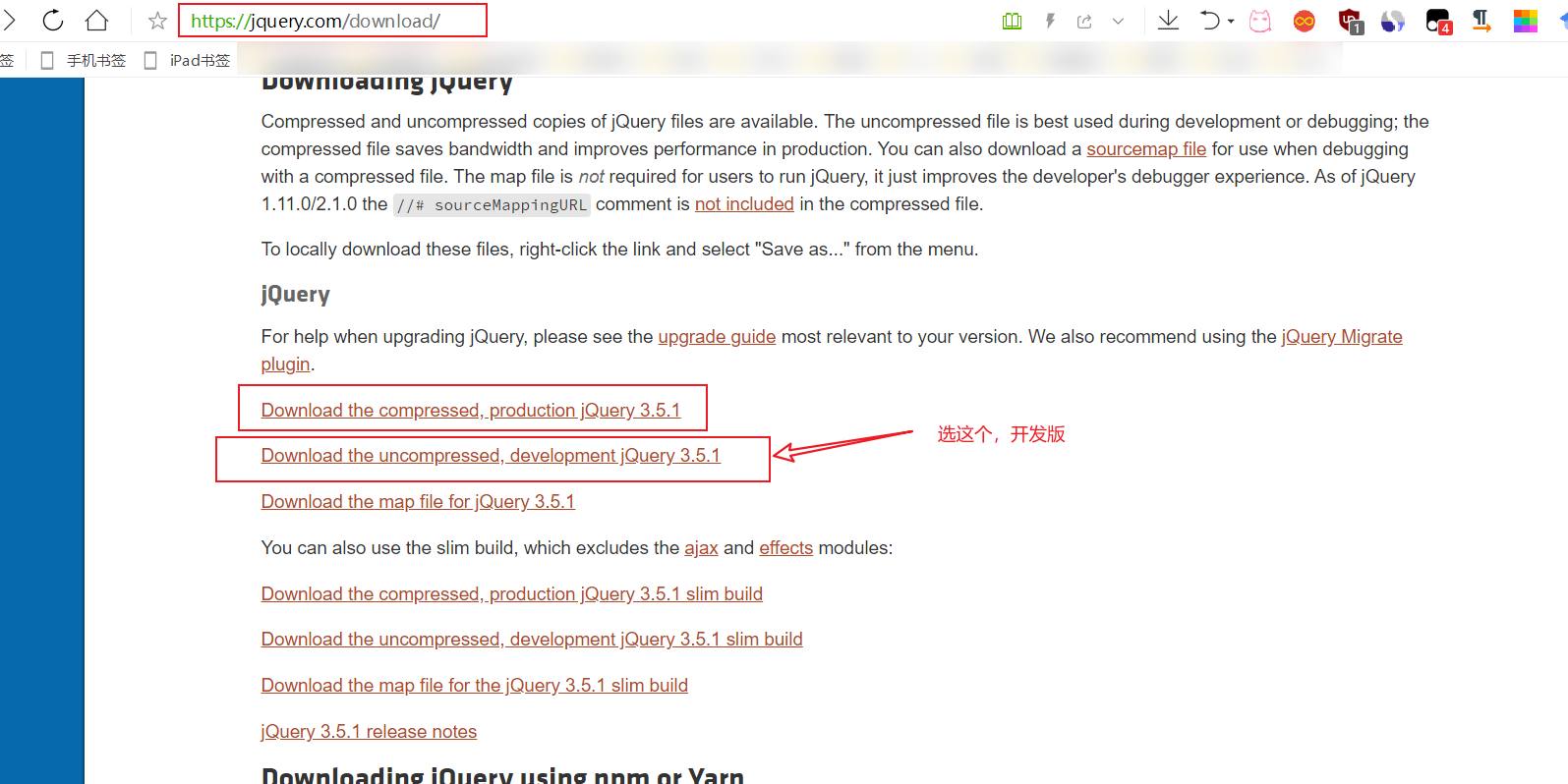

案例测试
- 配置web.xml 和 springmvc的配置文件,复制上面案例的即可 【记得静态资源过滤和注解驱动配置上】
1
2
3
4
5
6
7
8
9
10
11
12
13
14
15
16
17
18
19
20
21
22
23
24
25
26
27
28
29
30
31
32
33
34
35
36
37
38
39
40
41
42
43
44
| <?xml version="1.0" encoding="UTF-8"?>
<beans xmlns="http://www.springframework.org/schema/beans"
xmlns:xsi="http://www.w3.org/2001/XMLSchema-instance"
xmlns:context="http://www.springframework.org/schema/context"
xmlns:mvc="http://www.springframework.org/schema/mvc"
xsi:schemaLocation="http://www.springframework.org/schema/beans
http://www.springframework.org/schema/beans/spring-beans.xsd
http://www.springframework.org/schema/context
https://www.springframework.org/schema/context/spring-context.xsd
http://www.springframework.org/schema/mvc
https://www.springframework.org/schema/mvc/spring-mvc.xsd">
<context:component-scan base-package="com.github.test.controller"/>
<mvc:default-servlet-handler />
<mvc:annotation-driven />
<bean class="org.springframework.web.servlet.view.InternalResourceViewResolver"
id="internalResourceViewResolver">
<property name="prefix" value="/WEB-INF/jsp/" />
<property name="suffix" value=".jsp" />
</bean>
<mvc:annotation-driven>
<mvc:message-converters register-defaults="true">
<bean class="org.springframework.http.converter.StringHttpMessageConverter">
<constructor-arg value="UTF-8"/>
</bean>
<bean class="org.springframework.http.converter.json.MappingJackson2HttpMessageConverter">
<property name="objectMapper">
<bean class="org.springframework.http.converter.json.Jackson2ObjectMapperFactoryBean">
<property name="failOnEmptyBeans" value="false"/>
</bean>
</property>
</bean>
</mvc:message-converters>
</mvc:annotation-driven>
</beans>
|
- 编写一个AjaxController
1
2
3
4
5
6
7
8
9
10
11
12
13
14
15
16
17
18
19
20
21
| package com.github.test.controller;
import org.springframework.web.bind.annotation.RequestMapping;
import org.springframework.web.bind.annotation.RestController;
import javax.servlet.http.HttpServletResponse;
import java.io.IOException;
@RestController
public class AjaxController {
@RequestMapping("/a1")
public void a1(String name , HttpServletResponse response) throws IOException {
System.out.println("a1:param=>"+name);
if ("test".equals(name)){
response.getWriter().print("true");
}else{
response.getWriter().print("false");
}
}
}
|
- 导入jquery
1
| <script src="${pageContext.request.contextPath}/statics/js/jquery-3.5.1.js"></script>
|
- 编写index.jsp测试
1
2
3
4
5
6
7
8
9
10
11
12
13
14
15
16
17
18
19
20
21
22
23
24
25
26
27
| <%@ page contentType="text/html;charset=UTF-8" language="java" %>
<html>
<head>
<title>$Title$</title>
<script src="${pageContext.request.contextPath}/statics/js/jquery-3.5.1.js"></script>
<script>
function a(){
$.post({
url:"${pageContext.request.contextPath}/a1",
data:{'name':$("#username").val()},
success:function (data,status) {
console.log("data=" + data);
console.log("status=" + status);
}
});
}
</script>
</head>
<body>
<%-- 失去焦点的时候,发起一个请求到后台 --%>
用户名:<input type="text" id="txtName" onblur="a()"/>
</body>
</html>
|
- 启动tomcat测试!打开浏览器的控制台,当我们鼠标离开输入框的时候,可以看到发出了一个ajax的请求!是后台返回给我们的结果!测试成功!
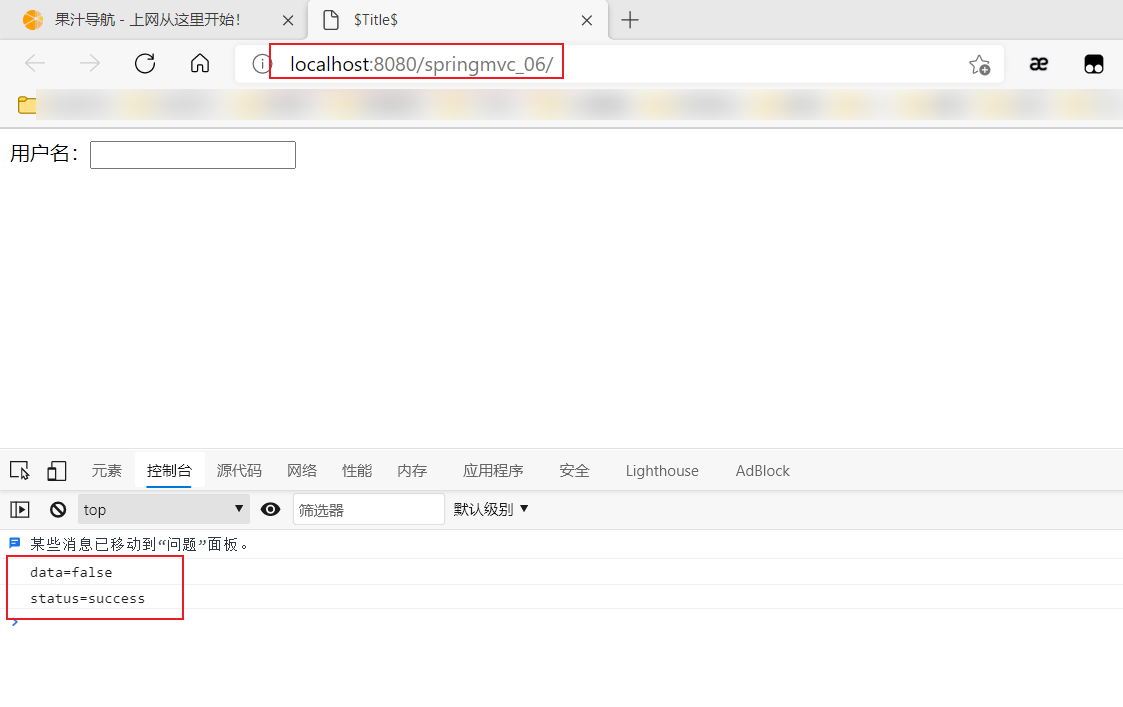
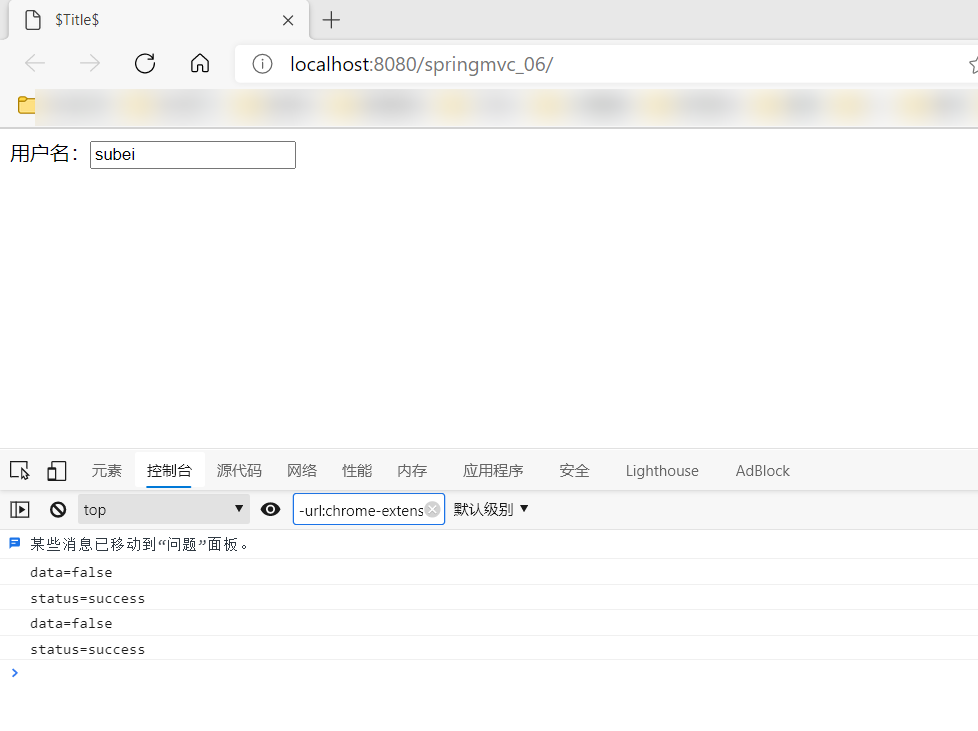
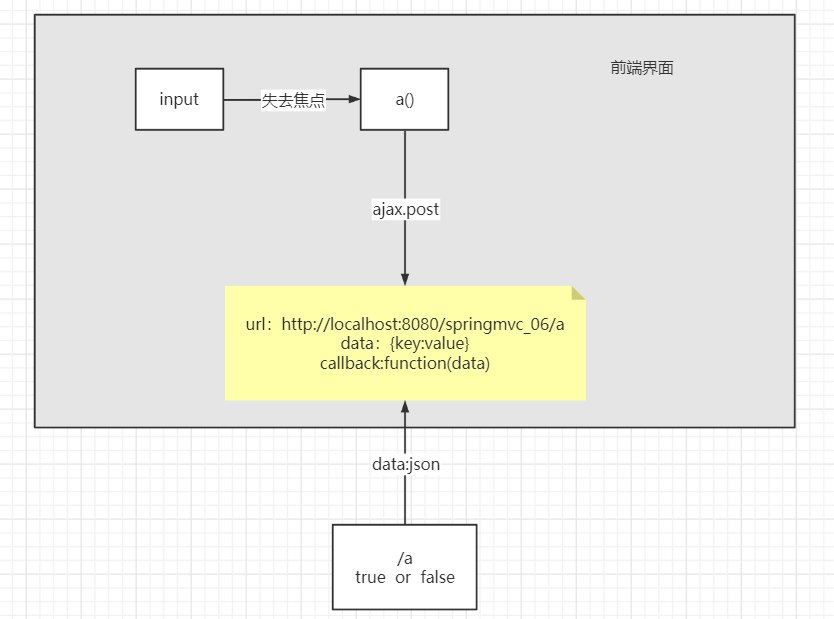
3.Ajax异步加载数据
1
2
3
4
5
6
7
8
9
10
11
12
13
14
15
| package com.github.test.pojo;
import lombok.AllArgsConstructor;
import lombok.Data;
import lombok.NoArgsConstructor;
@Data
@AllArgsConstructor
@NoArgsConstructor
public class User {
private String name;
private int age;
private String sex;
}
|
1
2
3
4
5
6
7
8
| @RequestMapping("/a2")
public List<User> a2(){
List<User> list = new ArrayList<User>();
list.add(new User("哇哈哈1号",9,"男"));
list.add(new User("哇哈哈2号",6,"男"));
list.add(new User("哇哈哈3号",1,"男"));
return list;
}
|
1
2
3
4
5
6
7
8
9
10
11
12
13
14
15
16
17
18
19
20
21
22
23
24
25
26
27
28
29
30
31
32
33
34
35
36
37
38
39
| <%@ page contentType="text/html;charset=UTF-8" language="java" %>
<html>
<head>
<title>Title</title>
</head>
<body>
<input type="button" id="btn" value="获取数据"/>
<table width="80%" align="center">
<tr>
<td>姓名</td>
<td>年龄</td>
<td>性别</td>
</tr>
<tbody id="content">
</tbody>
</table>
<script src="${pageContext.request.contextPath}/statics/js/jquery-3.5.1.js"></script>
<script>
$(function () {
$("#btn").click(function () {
$.post("${pageContext.request.contextPath}/a2",function (data) {
console.log(data)
var html="";
for (var i = 0; i <data.length ; i++) {
html+= "<tr>" +
"<td>" + data[i].name + "</td>" +
"<td>" + data[i].age + "</td>" +
"<td>" + data[i].sex + "</td>" +
"</tr>"
}
$("#content").html(html);
});
})
})
</script>
</body>
</html>
|

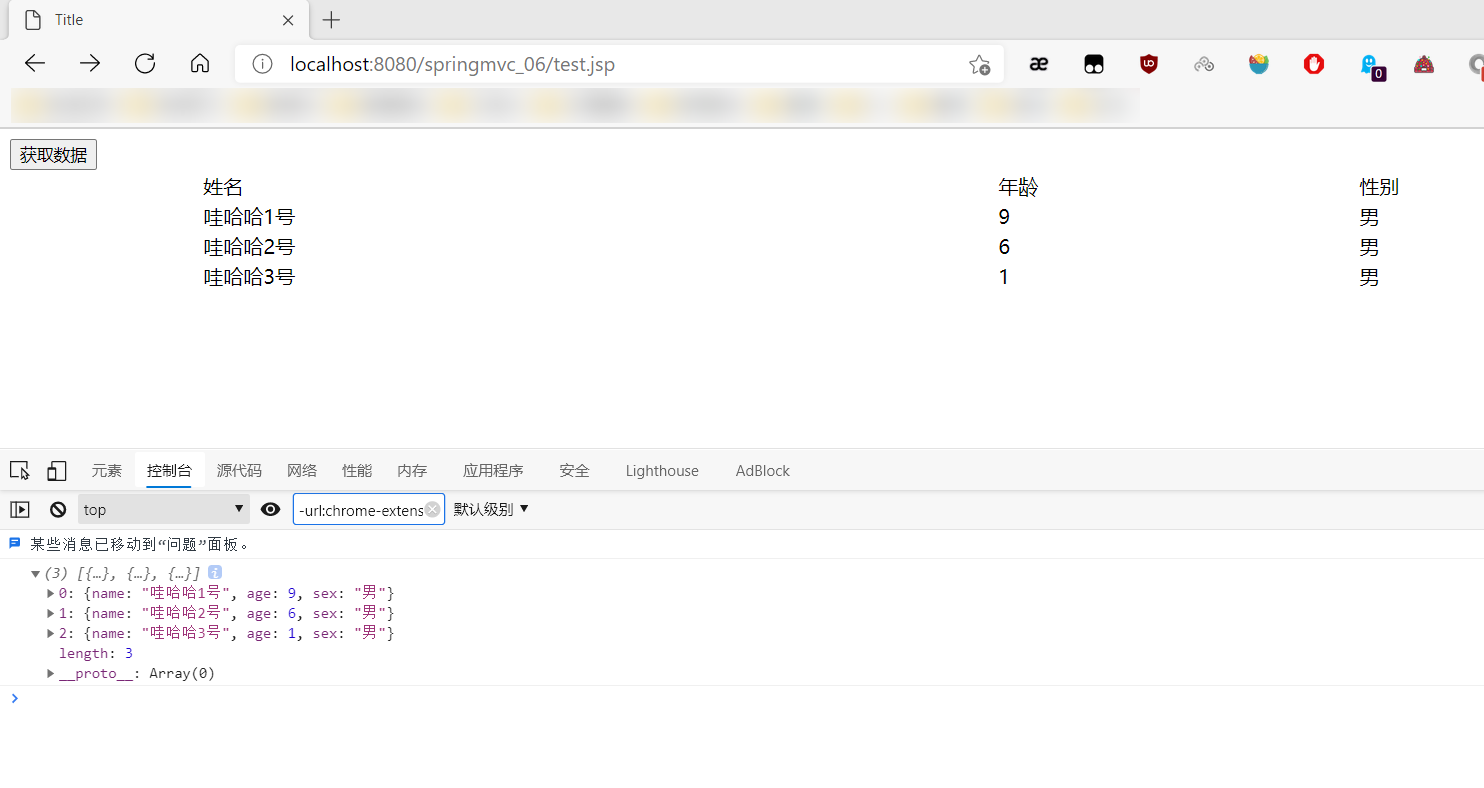
4.Ajax验证用户名体验
1
2
3
4
5
6
7
8
9
10
11
12
13
14
15
16
17
18
19
20
| @RequestMapping("/a3")
public String a3(String name,String pwd){
String msg = "";
if (name!=null){
if ("admin".equals(name)){
msg = "OK";
}else {
msg = "用户名输入错误";
}
}
if (pwd!=null){
if ("123456".equals(pwd)){
msg = "OK";
}else {
msg = "密码输入有误";
}
}
return msg;
}
|
1
2
3
4
5
6
7
8
9
10
11
12
13
14
15
16
17
18
19
20
21
22
23
24
25
26
27
28
29
30
31
32
33
34
35
36
37
38
39
40
41
42
43
44
45
46
47
48
49
| <%@ page contentType="text/html;charset=UTF-8" language="java" %>
<html>
<head>
<title>ajax</title>
<script src="${pageContext.request.contextPath}/statics/js/jquery-3.5.1.js"></script>
<script>
function a1(){
$.post({
url:"${pageContext.request.contextPath}/a3",
data:{'name':$("#name").val()},
success:function (data) {
if (data.toString()=='OK'){
$("#userInfo").css("color","green");
}else {
$("#userInfo").css("color","red");
}
$("#userInfo").html(data);
}
});
}
function a2(){
$.post({
url:"${pageContext.request.contextPath}/a3",
data:{'pwd':$("#pwd").val()},
success:function (data) {
if (data.toString()=='OK'){
$("#pwdInfo").css("color","green");
}else {
$("#pwdInfo").css("color","red");
}
$("#pwdInfo").html(data);
}
});
}
</script>
</head>
<body>
<p>
用户名:<input type="text" id="name" onblur="a1()"/>
<span id="userInfo"></span>
</p>
<p>
密码:<input type="text" id="pwd" onblur="a2()"/>
<span id="pwdInfo"></span>
</p>
</body>
</html>
|
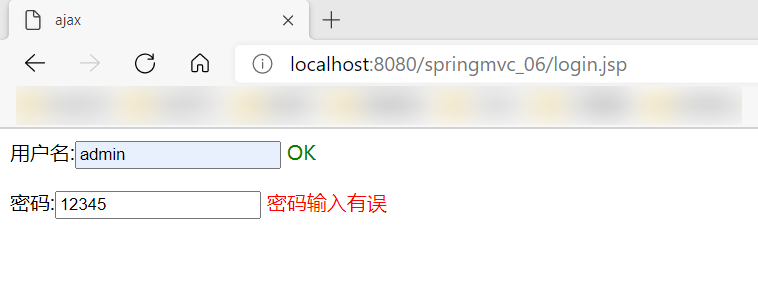
5.获取baidu接口Demo
1
2
3
4
5
6
7
8
9
10
11
12
13
14
15
16
17
18
19
20
21
22
23
24
25
26
27
28
29
30
31
32
33
34
35
36
37
38
39
40
41
42
43
44
45
46
47
48
49
50
51
52
53
54
55
56
57
58
59
60
61
62
63
64
65
66
67
68
69
70
71
72
73
74
75
76
77
78
79
80
81
82
83
84
| <!DOCTYPE HTML>
<html>
<head>
<meta http-equiv="Content-Type" content="text/html; charset=utf-8">
<title>JSONP百度搜索</title>
<style>
#q{
width: 500px;
height: 30px;
border:1px solid #ddd;
line-height: 30px;
display: block;
margin: 0 auto;
padding: 0 10px;
font-size: 14px;
}
#ul{
width: 520px;
list-style: none;
margin: 0 auto;
padding: 0;
border:1px solid #ddd;
margin-top: -1px;
display: none;
}
#ul li{
line-height: 30px;
padding: 0 10px;
}
#ul li:hover{
background-color: #f60;
color: #fff;
}
</style>
<script>
function demo(data){
var Ul = document.getElementById('ul');
var html = '';
if (data.s.length) {
Ul.style.display = 'block';
for(var i = 0;i<data.s.length;i++){
html += '<li>'+data.s[i]+'</li>';
}
Ul.innerHTML = html;
}
}
window.onload = function(){
var Q = document.getElementById('q');
var Ul = document.getElementById('ul');
Q.onkeyup = function(){
if (this.value != '') {
var script = document.createElement('script');
script.src = 'https://sp0.baidu.com/5a1Fazu8AA54nxGko9WTAnF6hhy/su?wd='+this.value+'&cb=demo';
document.body.appendChild(script);
}
}
}
</script>
</head>
<body>
<input type="text" id="q" />
<ul id="ul">
</ul>
</body>
</html>
|
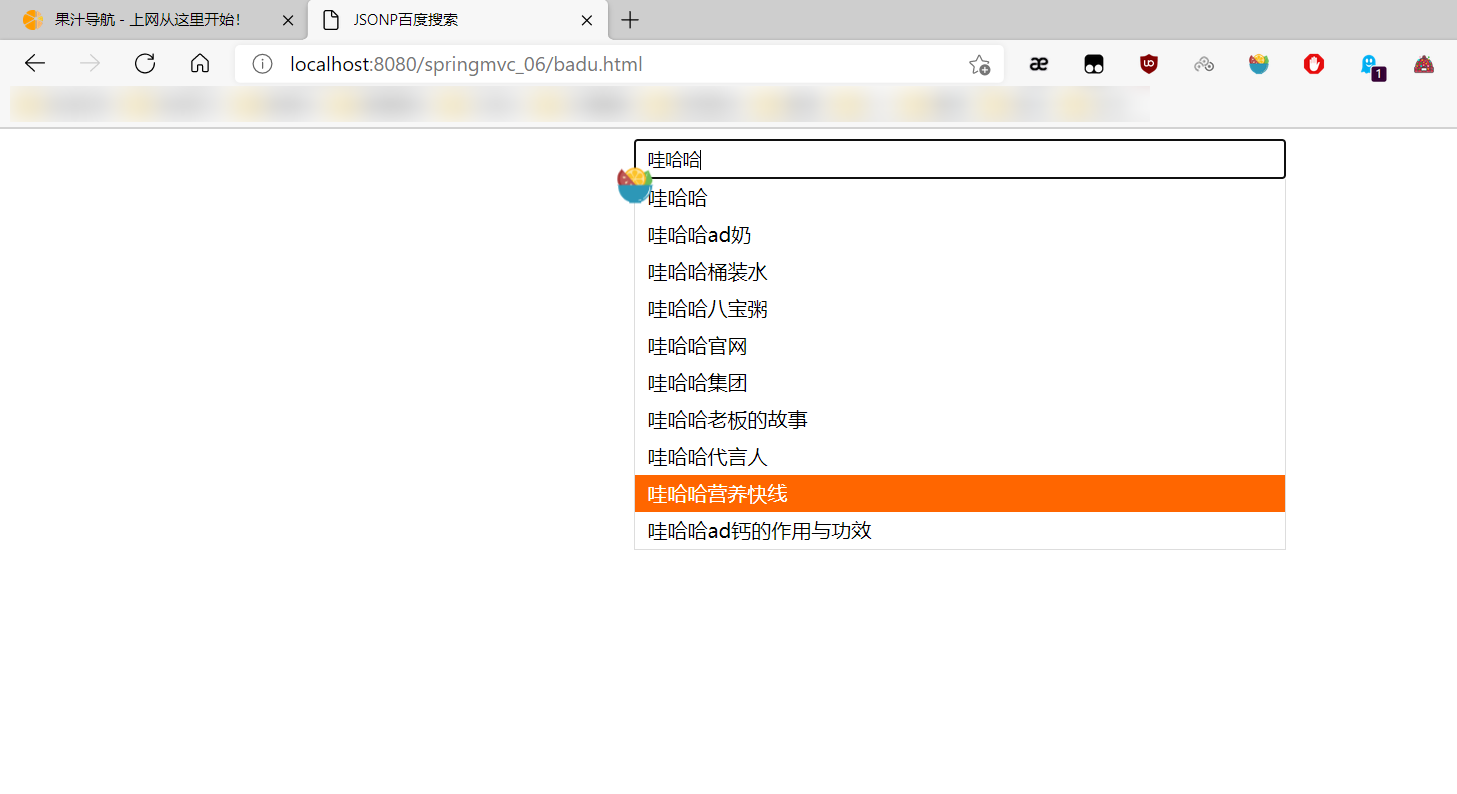
9、拦截器
1.概述
SpringMVC的处理器拦截器类似于Servlet开发中的过滤器Filter,用于对处理器进行预处理和后处理。开发者可以自己定义一些拦截器来实现特定的功能。
- 过滤器与拦截器的区别:拦截器是AOP思想的具体应用。
过滤器
- servlet规范中的一部分,任何java web工程都可以使用
- 在url-pattern中配置了/*之后,可以对所有要访问的资源进行拦截
拦截器
- 拦截器是SpringMVC框架自己的,只有使用了SpringMVC框架的工程才能使用
- 拦截器只会拦截访问的控制器方法, 如果访问的是jsp/html/css/image/js是不会进行拦截的
2.自定义拦截器
那如何实现拦截器呢?
想要自定义拦截器,必须实现 HandlerInterceptor 接口。
1、新建一个Moudule , springmvc-07-Interceptor , 添加web支持。

2、配置web.xml 和 applicationContext.xml 文件
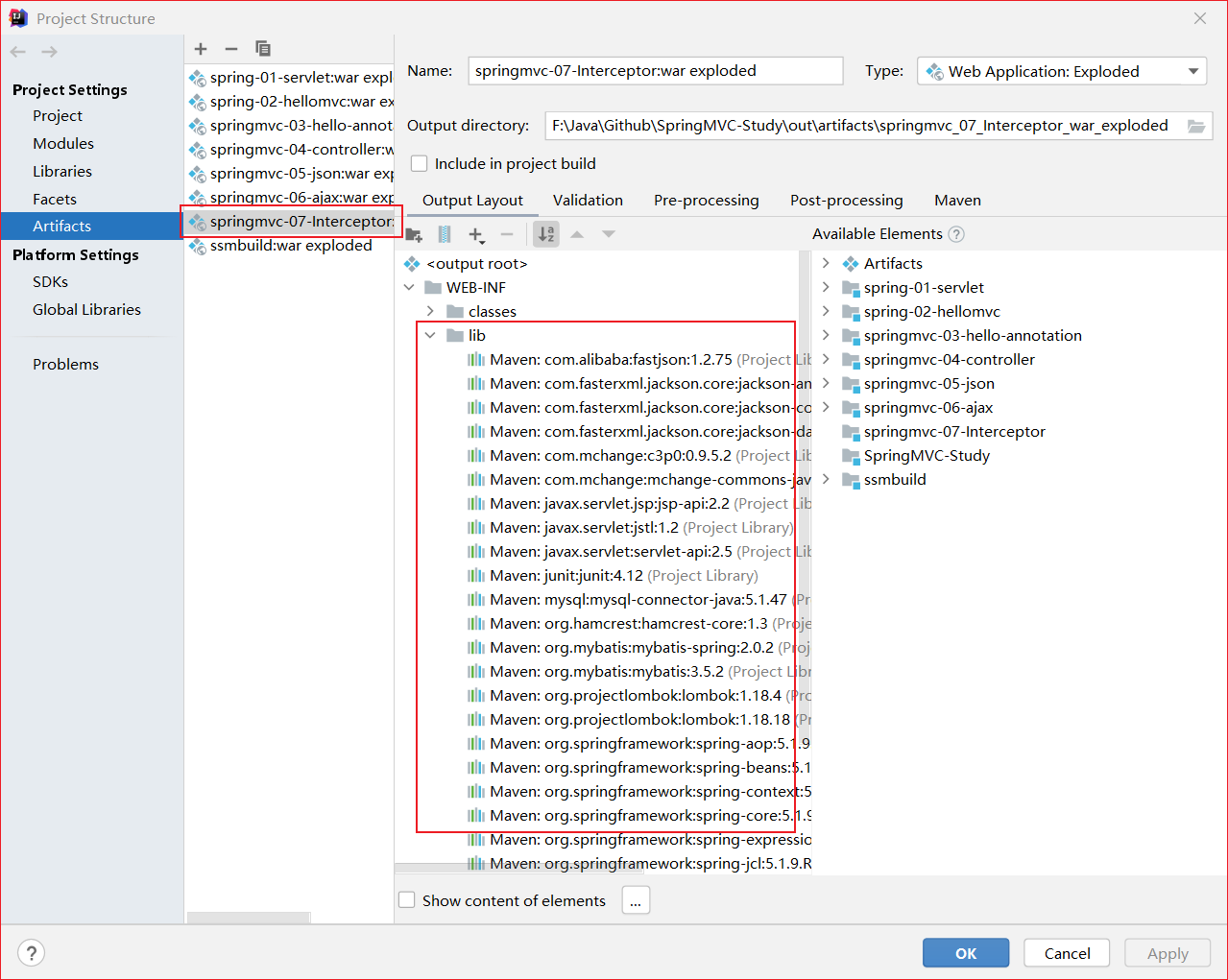
1
2
3
4
5
6
7
8
9
10
11
12
13
14
15
16
17
18
19
20
21
22
23
24
25
26
27
28
29
30
31
32
33
| <?xml version="1.0" encoding="UTF-8"?>
<web-app xmlns="http://xmlns.jcp.org/xml/ns/javaee"
xmlns:xsi="http://www.w3.org/2001/XMLSchema-instance"
xsi:schemaLocation="http://xmlns.jcp.org/xml/ns/javaee http://xmlns.jcp.org/xml/ns/javaee/web-app_4_0.xsd"
version="4.0">
<servlet>
<servlet-name>springmvc</servlet-name>
<servlet-class>org.springframework.web.servlet.DispatcherServlet</servlet-class>
<init-param>
<param-name>contextConfigLocation</param-name>
<param-value>classpath:applicationContext.xml</param-value>
</init-param>
<load-on-startup>1</load-on-startup>
</servlet>
<servlet-mapping>
<servlet-name>springmvc</servlet-name>
<url-pattern>/</url-pattern>
</servlet-mapping>
<filter>
<filter-name>encoding</filter-name>
<filter-class>org.springframework.web.filter.CharacterEncodingFilter</filter-class>
<init-param>
<param-name>encoding</param-name>
<param-value>utf-8</param-value>
</init-param>
</filter>
<filter-mapping>
<filter-name>encoding</filter-name>
<url-pattern>/*</url-pattern>
</filter-mapping>
</web-app>
|
1
2
3
4
5
6
7
8
9
10
11
12
13
14
15
16
17
18
19
20
21
22
23
24
25
26
27
28
29
30
31
32
33
34
35
36
37
38
39
40
41
42
43
44
| <?xml version="1.0" encoding="UTF-8"?>
<beans xmlns="http://www.springframework.org/schema/beans"
xmlns:xsi="http://www.w3.org/2001/XMLSchema-instance"
xmlns:context="http://www.springframework.org/schema/context"
xmlns:mvc="http://www.springframework.org/schema/mvc"
xsi:schemaLocation="http://www.springframework.org/schema/beans
http://www.springframework.org/schema/beans/spring-beans.xsd
http://www.springframework.org/schema/context
https://www.springframework.org/schema/context/spring-context.xsd
http://www.springframework.org/schema/mvc
https://www.springframework.org/schema/mvc/spring-mvc.xsd">
<context:component-scan base-package="com.github.test.controller"/>
<mvc:default-servlet-handler />
<mvc:annotation-driven />
<bean class="org.springframework.web.servlet.view.InternalResourceViewResolver"
id="internalResourceViewResolver">
<property name="prefix" value="/WEB-INF/jsp/" />
<property name="suffix" value=".jsp" />
</bean>
<mvc:annotation-driven>
<mvc:message-converters register-defaults="true">
<bean class="org.springframework.http.converter.StringHttpMessageConverter">
<constructor-arg value="UTF-8"/>
</bean>
<bean class="org.springframework.http.converter.json.MappingJackson2HttpMessageConverter">
<property name="objectMapper">
<bean class="org.springframework.http.converter.json.Jackson2ObjectMapperFactoryBean">
<property name="failOnEmptyBeans" value="false"/>
</bean>
</property>
</bean>
</mvc:message-converters>
</mvc:annotation-driven>
</beans>
|
- 编写一个拦截器
1
2
3
4
5
6
7
8
9
10
11
12
13
14
15
16
17
18
19
20
21
22
23
24
25
26
27
28
29
30
31
32
33
34
35
36
| package com.github.test.interceptor;
import org.springframework.web.servlet.HandlerInterceptor;
import org.springframework.web.servlet.ModelAndView;
import javax.servlet.http.HttpServletRequest;
import javax.servlet.http.HttpServletResponse;
package com.github.test.interceptor;
import org.springframework.web.servlet.HandlerInterceptor;
import org.springframework.web.servlet.ModelAndView;
import javax.servlet.http.HttpServletRequest;
import javax.servlet.http.HttpServletResponse;
public class Interceptor implements HandlerInterceptor {
public boolean preHandle(HttpServletRequest httpServletRequest, HttpServletResponse httpServletResponse, Object o) throws Exception {
System.out.println("------------处理前------------");
return true;
}
public void postHandle(HttpServletRequest httpServletRequest, HttpServletResponse httpServletResponse, Object o, ModelAndView modelAndView) throws Exception {
System.out.println("------------处理后------------");
}
public void afterCompletion(HttpServletRequest httpServletRequest, HttpServletResponse httpServletResponse, Object o, Exception e) throws Exception {
System.out.println("------------清理------------");
}
}
|
- 在applicationContext.xml的配置文件中配置拦截器
1
2
3
4
5
6
7
8
9
10
11
|
<mvc:interceptors>
<mvc:interceptor>
<mvc:mapping path="/**"/>
<bean class="com.github.test.interceptor.Interceptor"/>
</mvc:interceptor>
</mvc:interceptors>
|
- 编写一个Controller,接收请求
1
2
3
4
5
6
7
8
9
10
11
12
13
14
15
16
| package com.github.test.controller;
import org.springframework.stereotype.Controller;
import org.springframework.web.bind.annotation.RequestMapping;
import org.springframework.web.bind.annotation.ResponseBody;
@Controller
public class InterceptorController {
@RequestMapping("/k1")
@ResponseBody
public String testFunction() {
System.out.println("控制器中的方法执行了==》");
return "hello";
}
}
|
- 前端 index.jsp
1
2
3
4
5
6
7
8
9
| <%@ page contentType="text/html;charset=UTF-8" language="java" %>
<html>
<head>
<title>$Title$</title>
</head>
<body>
<a href="${pageContext.request.contextPath}/k1">拦截器测试</a>
</body>
</html>
|
7、启动tomcat 测试一下!


3.验证用户是否登录
实现思路
- 有一个登陆页面,需要写一个controller访问页面。
- 登陆页面有一提交表单的动作。需要在controller中处理。判断用户名密码是否正确。如果正确,向session中写入用户信息。返回登陆成功。
- 拦截用户请求,判断用户是否登陆。如果用户已经登陆。放行, 如果用户未登陆,跳转到登陆页面
案例测试:
- 编写一个登陆页面 login.jsp

1
2
3
4
5
6
7
8
9
10
11
12
13
14
15
16
17
| <%@ page contentType="text/html;charset=UTF-8" language="java" %>
<html>
<head>
<title>Title</title>
</head>
<h1>登录页面</h1>
<hr>
<body>
<form action="${pageContext.request.contextPath}/user/login">
用户名:<input type="text" name="username"> <br>
密码:<input type="password" name="pwd"> <br>
<input type="submit" value="提交">
</form>
</body>
</html>
|
- 编写一个Controller处理请求
1
2
3
4
5
6
7
8
9
10
11
12
13
14
15
16
17
18
19
20
21
22
23
24
25
26
27
28
29
30
31
32
33
34
35
36
37
38
39
40
| package com.github.test.controller;
import org.springframework.stereotype.Controller;
import org.springframework.web.bind.annotation.RequestMapping;
import javax.servlet.http.HttpSession;
@Controller
@RequestMapping("/user")
public class UserController {
@RequestMapping("/jumplogin")
public String jumpLogin() throws Exception {
return "login";
}
@RequestMapping("/jumpSuccess")
public String jumpSuccess() throws Exception {
return "success";
}
@RequestMapping("/login")
public String login(HttpSession session, String username, String pwd) throws Exception {
System.out.println("接收前端==="+username);
session.setAttribute("user", username);
return "success";
}
@RequestMapping("logout")
public String logout(HttpSession session) throws Exception {
session.invalidate();
return "login";
}
}
|
- 编写一个登陆成功的页面 success.jsp
1
2
3
4
5
6
7
8
9
10
11
12
13
14
| <%@ page contentType="text/html;charset=UTF-8" language="java" %>
<html>
<head>
<title>Title</title>
</head>
<body>
<h1>登录成功页面</h1>
<hr>
${user}
<a href="${pageContext.request.contextPath}/user/logout">注销</a>
</body>
</html>
|
- 在 index.jsp 页面上测试跳转!启动Tomcat 测试,未登录也可以进入主页!
1
2
3
4
5
6
7
8
9
10
11
| <%@ page contentType="text/html;charset=UTF-8" language="java" %>
<html>
<head>
<title>$Title$</title>
</head>
<body>
<%--登录--%>
<a href="${pageContext.request.contextPath}/user/jumplogin">登录</a>
<a href="${pageContext.request.contextPath}/user/jumpSuccess">成功页面</a>
</body>
</html>
|
- 编写用户登录拦截器
1
2
3
4
5
6
7
8
9
10
11
12
13
14
15
16
17
18
19
20
21
22
23
24
25
26
27
28
29
30
31
32
33
34
35
36
37
38
39
40
| package com.github.test.interceptor;
import org.springframework.web.servlet.HandlerInterceptor;
import org.springframework.web.servlet.ModelAndView;
import javax.servlet.ServletException;
import javax.servlet.http.HttpServletRequest;
import javax.servlet.http.HttpServletResponse;
import javax.servlet.http.HttpSession;
import java.io.IOException;
public class LoginInterceptor implements HandlerInterceptor {
public boolean preHandle(HttpServletRequest request, HttpServletResponse response, Object handler) throws ServletException, IOException, ServletException, IOException {
System.out.println("uri: " + request.getRequestURI());
if (request.getRequestURI().contains("login")) {
return true;
}
HttpSession session = request.getSession();
if(session.getAttribute("user") != null) {
return true;
}
request.getRequestDispatcher("/WEB-INF/jsp/login.jsp").forward(request, response);
return false;
}
public void postHandle(HttpServletRequest httpServletRequest, HttpServletResponse httpServletResponse, Object o, ModelAndView modelAndView) throws Exception {
}
public void afterCompletion(HttpServletRequest httpServletRequest, HttpServletResponse httpServletResponse, Object o, Exception e) throws Exception {
}
}
|
- 在applicationContext.xml的配置文件中注册拦截器
1
2
3
4
5
6
7
8
9
10
11
| <!--关于拦截器的配置-->
<mvc:interceptors>
<mvc:interceptor>
<!--
|
- 再次重启Tomcat测试!



10、文件上传和下载
1.准备工作
文件上传是项目开发中最常见的功能之一 ,springMVC 可以很好的支持文件上传,但是SpringMVC上下文中默认没有装配MultipartResolver,因此默认情况下其不能处理文件上传工作。如果想使用Spring的文件上传功能,则需要在上下文中配置MultipartResolver。
前端表单要求:为了能上传文件,必须将表单的method设置为POST,并将enctype设置为multipart/form-data。只有在这样的情况下,浏览器才会把用户选择的文件以二进制数据发送给服务器;
对表单中的 enctype 属性做个详细的说明:
- application/x-www=form-urlencoded:默认方式,只处理表单域中的 value 属性值,采用这种编码方式的表单会将表单域中的值处理成 URL 编码方式。
- multipart/form-data:这种编码方式会以二进制流的方式来处理表单数据,这种编码方式会把文件域指定文件的内容也封装到请求参数中,不会对字符编码。
- text/plain:除了把空格转换为 “+” 号外,其他字符都不做编码处理,这种方式适用直接通过表单发送邮件。
1
2
3
4
| <form action="" enctype="multipart/form-data" method="post">
<input type="file" name="file"/>
<input type="submit">
</form>
|
一旦设置了enctype为multipart/form-data,浏览器即会采用二进制流的方式来处理表单数据,而对于文件上传的处理则涉及在服务器端解析原始的HTTP响应。在2003年,Apache Software Foundation发布了开源的Commons FileUpload组件,其很快成为Servlet/JSP程序员上传文件的最佳选择。
- Servlet3.0规范已经提供方法来处理文件上传,但这种上传需要在Servlet中完成。
- 而Spring MVC则提供了更简单的封装。
- Spring MVC为文件上传提供了直接的支持,这种支持是用即插即用的MultipartResolver实现的。
- Spring MVC使用Apache Commons FileUpload技术实现了一个MultipartResolver实现类:
- CommonsMultipartResolver。因此,SpringMVC的文件上传还需要依赖Apache Commons FileUpload的组件。
2.文件上传
- 导入文件上传的jar包,commons-fileupload , Maven会自动帮我们导入依赖包 commons-io包;

1
2
3
4
5
6
7
8
9
10
11
12
13
14
15
| <dependencies>
<dependency>
<groupId>commons-fileupload</groupId>
<artifactId>commons-fileupload</artifactId>
<version>1.3.3</version>
</dependency>
<dependency>
<groupId>javax.servlet</groupId>
<artifactId>javax.servlet-api</artifactId>
<version>3.0.1</version>
<scope>provided</scope>
</dependency>
</dependencies>
|
- 配置bean:multipartResolver,在 applicationContext.xml 中配置。
【注意!!!这个bena的id必须为:multipartResolver , 否则上传文件会报400的错误!在这里栽过坑,教训!】
1
2
3
4
5
6
7
8
9
10
11
12
13
14
15
16
17
18
19
20
21
22
23
24
25
26
27
28
29
30
31
32
33
34
35
36
37
38
39
40
41
42
43
44
45
46
47
48
49
50
51
52
53
| <?xml version="1.0" encoding="UTF-8"?>
<beans xmlns="http://www.springframework.org/schema/beans"
xmlns:xsi="http://www.w3.org/2001/XMLSchema-instance"
xmlns:context="http://www.springframework.org/schema/context"
xmlns:mvc="http://www.springframework.org/schema/mvc"
xsi:schemaLocation="http://www.springframework.org/schema/beans
http://www.springframework.org/schema/beans/spring-beans.xsd
http://www.springframework.org/schema/context
https://www.springframework.org/schema/context/spring-context.xsd
http://www.springframework.org/schema/mvc
https://www.springframework.org/schema/mvc/spring-mvc.xsd">
<context:component-scan base-package="com.github.test.controller"/>
<mvc:default-servlet-handler />
<mvc:annotation-driven />
<bean class="org.springframework.web.servlet.view.InternalResourceViewResolver"
id="internalResourceViewResolver">
<property name="prefix" value="/WEB-INF/jsp/" />
<property name="suffix" value=".jsp" />
</bean>
<bean id="multipartResolver" class="org.springframework.web.multipart.commons.CommonsMultipartResolver">
<property name="defaultEncoding" value="utf-8"/>
<property name="maxUploadSize" value="10485760"/>
<property name="maxInMemorySize" value="40960"/>
</bean>
<mvc:annotation-driven>
<mvc:message-converters register-defaults="true">
<bean class="org.springframework.http.converter.StringHttpMessageConverter">
<constructor-arg value="UTF-8"/>
</bean>
<bean class="org.springframework.http.converter.json.MappingJackson2HttpMessageConverter">
<property name="objectMapper">
<bean class="org.springframework.http.converter.json.Jackson2ObjectMapperFactoryBean">
<property name="failOnEmptyBeans" value="false"/>
</bean>
</property>
</bean>
</mvc:message-converters>
</mvc:annotation-driven>
</beans>
|
CommonsMultipartFile 的 常用方法:
- String getOriginalFilename():获取上传文件的原名
- InputStream getInputStream():获取文件流
- void transferTo(File dest):将上传文件保存到一个目录文件中
- 编写前端页面,index.jsp
1
2
3
4
5
6
7
8
9
10
11
12
| <%@ page contentType="text/html;charset=UTF-8" language="java" %>
<html>
<head>
<title>$Title$</title>
</head>
<body>
<form action="${pageContext.request.contextPath}/upload" enctype="multipart/form-data" method="post">
<input type="file" name="file"/>
<input type="submit" value="upload">
</form>
</body>
</html>
|
- Controller
1
2
3
4
5
6
7
8
9
10
11
12
13
14
15
16
17
18
19
20
21
22
23
24
25
26
27
28
29
30
31
32
33
34
35
36
37
38
39
40
41
42
43
44
45
46
47
48
49
50
| package com.github.test.controller;
import org.springframework.stereotype.Controller;
import org.springframework.web.bind.annotation.RequestMapping;
import org.springframework.web.bind.annotation.RequestParam;
import org.springframework.web.multipart.commons.CommonsMultipartFile;
import javax.servlet.http.HttpServletRequest;
import java.io.*;
@Controller
public class FileController {
@RequestMapping("/upload")
public String fileUpload(@RequestParam("file") CommonsMultipartFile file , HttpServletRequest request) throws IOException {
String uploadFileName = file.getOriginalFilename();
if ("".equals(uploadFileName)){
return "redirect:/index.jsp";
}
System.out.println("上传文件名 : "+uploadFileName);
String path = request.getServletContext().getRealPath("/upload");
File realPath = new File(path);
if (!realPath.exists()){
realPath.mkdir();
}
System.out.println("上传文件保存地址:"+realPath);
InputStream is = file.getInputStream();
OutputStream os = new FileOutputStream(new File(realPath,uploadFileName));
int len=0;
byte[] buffer = new byte[1024];
while ((len=is.read(buffer))!=-1){
os.write(buffer,0,len);
os.flush();
}
os.close();
is.close();
return "redirect:/index.jsp";
}
}
|
报错:Cannot resolve method ‘getServletContext’ in ‘HttpServletRequest’
- 这个报错原因是因为pom依赖导包
servlet-api的版本错误: - 在调用request.getServletContext()的方法需要
servlet-api的版本3.0以上才可以。 - 所以把之前的版本修改一下就可以了,修改为4.0.1版本即可。如下:
1
2
3
4
5
6
| <dependency>
<groupId>javax.servlet</groupId>
<artifactId>javax.servlet-api</artifactId>
<version>4.0.1</version>
<scope>provided</scope>
</dependency>
|
- 测试上传,成功!!!


采用file.Transto 来保存上传的文件
- 编写Controller
1
2
3
4
5
6
7
8
9
10
11
12
13
14
15
16
17
18
19
20
|
@RequestMapping("/upload2")
public String fileUpload2(@RequestParam("file") CommonsMultipartFile file, HttpServletRequest request) throws IOException {
String path = request.getServletContext().getRealPath("/upload");
File realPath = new File(path);
if (!realPath.exists()){
realPath.mkdir();
}
System.out.println("上传文件保存地址:"+realPath);
file.transferTo(new File(realPath +"/"+ file.getOriginalFilename()));
return "redirect:/index.jsp";
}
|
- 前端表单提交地址修改

- 访问提交测试,OK!

3.文件下载
文件下载步骤:
设置 response 响应头
读取文件 – InputStream
写出文件 – OutputStream
执行操作
关闭流 (先开后关)
代码实现:
1
2
3
4
5
6
7
8
9
10
11
12
13
14
15
16
17
18
19
20
21
22
23
24
25
26
27
28
29
30
31
| @RequestMapping(value="/download")
public String downloads(HttpServletResponse response ,HttpServletRequest request) throws Exception{
String path = request.getServletContext().getRealPath("/upload");
String fileName = "winter.jpg";
response.reset();
response.setCharacterEncoding("UTF-8");
response.setContentType("multipart/form-data");
response.setHeader("Content-Disposition",
"attachment;fileName="+URLEncoder.encode(fileName, "UTF-8"));
File file = new File(path,fileName);
InputStream input=new FileInputStream(file);
OutputStream out = response.getOutputStream();
byte[] buff =new byte[1024];
int index=0;
while((index= input.read(buff))!= -1){
out.write(buff, 0, index);
out.flush();
}
out.close();
input.close();
return null;
}
|
1
| <a href="${pageContext.request.contextPath}/download">点击下载</a>
|































































































































































